1. Structure of English Words
2. Plan
• Morpheme as the important
component of word structure.
• Types of morphemes. Allomorphs.
• Types of affixes.
• Immediate Constituents Analysis.
3.
• The most important component of word
structure is the morpheme – the smallest
unit of language that carries information
about meaning or function.
• Builder → 2 morphemes: build (with
the meaning of “construct”) and -er
(which indicates that the entire word
functions as a noun with the meaning
“one who builds”).
• Houses → house (with the meaning of
“dwelling”) and -s (with the meaning of
“more than one”).
4. A word may consist of one, two or more morphemes:
• act, act-ive, act-iv-ate, re-act-iv-ate.
• Morphemes are the smallest indivisible twofacet language units. They are always used
as parts of words.
free (boy)
A free morpheme
coincides with the stem
or a word-form.
bound (-s)
A bound morpheme
occurs only as a
constituent part of a word.
• Affixes are bound morphemes.
5.
• Morphemes in various texts can have
different phonemic shapes.
• All the representatives of the given
morpheme are called allomorphs (from
Greek allos «other») of that morpheme.
• The morpheme used to express
indefiniteness in English, for instance, has
two forms – a before a word that begins with
a consonant (a car) and an before a word
that begins with a vowel (an accent).
• The variant forms of a morpheme are its
allomorphs.
6.
• Cats → /s/
• Dogs → /z/
• Judges → /iz/
Selection of the proper allomorph is dependent
on phonological facts.
• Assert → [ t ]
• Assertion → [ ∫ ]
• Permit – permiss-ive, electric – electricity,
impress – impress-ion.
An allomorph is a positional variant of that or
this morpheme occurring in a specific
environment.
7.
• Words can have two or more parts: a core
called a root and one or more parts added to
it and called affixes (something fixed or
attached to something else).
• The root is the morpheme that expresses the
lexical meaning of the word: teach – teacher
– teaching.
• Affixes are morphemes that modify the
meaning of the root.
• An affix added before the root is called a
prefix; an affix added after the root is called a
suffix.
8.
9.
A word may have one or more affixes of
either kind, or several of both kinds:
Prefix
Root
Suffix (es) Example
un-
work
-able
unworkable
fright
-en; -ing
frightening
re-
play
replay
10.
• A root constitutes the core of the word and
carries the major component of its meaning.
• To find the root, you have to remove any affix
there may be: the root -morph- (form)
remains after we remove the affixes a- and ous from amorphous.
• Roots have more specific and definite
meaning than prefixes or suffixes:
• -aqua- (water) in aquarium,
• -cent- (hundred) in centennial,
• -neo- (new) in neologism, etc.
11.
12.
Roots belong to a lexical category, such as
noun (N), verb (V), adjective (A), or
preposition (P).
• Nouns typically refer to concrete and abstract
things (door, intelligence);
• verbs tend to denote actions (stop, read);
• adjectives usually name properties (kind,
blue);
• prepositions encode spatial relations (in,
near).
Unlike roots, affixes do not belong to a lexical
category and are always bound morphemes:
• -er (a bound morpheme) combines with teach
(a verb), → a noun with the meaning «one
who teaches“.
13. A base (stem) is the form to which an affix is added
• In many cases, the base is also the
root: books.
• In other cases, however, the base can
be larger than a root: blackened. Black
is not only the root for the entire word
but also the base for -en. The unit
blacken, on the other hand, is simply
the base for -ed.
14. One should distinguish between suffixes and inflections.
One should distinguish between
suffixes and inflections.
Suffixes can form a new part of speech:
beauty — beautiful.
They can also change the meaning of
the root: black — blackish.
Inflections are morphemes used to
change grammar forms of the word:
work – works – worked – working.
English is not a highly inflected
language٭.
15.
16. Four structural types of words in English:
• simple (root) words consist of one root morpheme (&
an inflexion): boy, warm, law, tables, tenth;
• derived words consist of one root morpheme, one or
several affixes (& an inflexion): unmanageable,
lawful;
• compound words consist of two or more root
morphemes (& an inflexion): boyfriend, outlaws;
• compound-derived words consist of two or more
root morphemes, one or more affixes (& an inflexion):
left-handed, warm-hearted, blue-eyed.
17.
In conformity with structural types of
words we distinguish two main
types of word-formation:
• word-derivation (encouragement,
irresistible, worker) and
• word-composition (class board,
day-dream, weekend).
18. WORD FORMATION
W Derivation
Affixation
W Composition
Conversion
Derivational Composition
19. Immediate Constituents Analysis
• The theory of Immediate Constituents
(I.C.) was originally set forth by L.
Bloomfield as an attempt to
determine the ways in which lexical
units are related to one another.
• This kind of analysis is used in
lexicology mainly to discover the
derivational structure of lexical
units.
20.
21.
• Immediate constituents are any of the two
meaningful parts of a word.
• The main constituents are an affix and a stem.
• ungentlemanly – consists of a negative prefix
un- + an adjective stem.
• First we separate a free and a bound forms: un+ gentlemanly and gentleman + -ly.
• Then we break gentleman: gentle + man.
• At any level we obtain only two ICs, one of
which is a stem.
• The formula is: un + (gentle + man) + ly.
22.
• eatable consists of two ICs: eat + able
and may be described as a suffixal
derivative
• uneatable possesses a different
structure: the two ICs are un + eatable
which shows that this adjective is a
prefixal derivative.
• snow-covered = snow + covered
(a compound)
• blue-eyed = (blue + eye) + ed
(a suffixal derivative)
23.
• KEY TERMS:
• morpheme – the smallest bit of language that
has its own meaning, either a word or a part
of a word;
• free – (not in a fixed position or) not joined to
anything;
• bound – tied with;
• root (of a word) – is its most basic form, to
which other parts, such as affixes, can be
added;
• affix – a letter or group of letters which are
added to the beginning or end of a word to
make a new word.
24.
25. Key terms:
+ immediate constituents analysis
Morphological Structure of English Words
The word as an autonomous unit of the language system should be distinguished from another fundamental language unit – the morpheme.
A morpheme Ø Is an association of a given meaning with a given sound pattern, which makes it similar to a word. Ø Unlike a word, a morpheme is not autonomous, morphemes occur in speech only as constituent parts of words. Ø Cannot be divided into smaller meaningful units, so it is defined as the minimum meaningful unit of the language system.
According to their form Morphemes Free Bound Semi-bound (semi-free)
Free morphemes Are capable of forming words without adding other morphemes, which means that they coincide with the stems or independent forms of words: Ø House- (morpheme) = house (word) Ø Shoe- (morpheme) = shoe (word) Ø Bread- (morpheme) = bread (word)
Bound morphemes Ø May not stand alone without a loss or change of their meaning, they are always bound to something else. It means that they do not coincide with stems or independent forms of words: Ø Horr- (morpheme) – horr-or (word) Ø Agit- (morpheme) – agit-ate (word) Ø Nat- (morpheme) – nat-ion (word) Ø -Ible (morpheme) – elig-ible (word) Ø Pre- (morpheme) – pre-war (word)
Free and Bound morphemes Ø Prefixes and suffixes (jointly called derivational affixes) are always bound Ø Root morphemes may be both free and bound Ø Bound root morphemes are mainly found among loan words: arrogance, char-ity, cour-age, dis-tort, involve, toler-able, etc.
Semi-bound (semi-free) morphemes Ø Can function in a morphemic sequence both as an affix and as a free morpheme: Ø E. g. , the morphemes «well» and «half» can occur as free morphemes (cf. sleep well, half an hour) or as bound morphemes (cf. well-known, half-done)
According to their role in constructing words Morphemes Roots Affixes
According to their position in a word Affixes Suffixes Prefixes Infixes (unproductive in English)
According to their function and meaning Affixes Derivational Functional (Endings, inflexions)
A stem When a derivational or functional affix is stripped from the word, what remains is a stem (a stem base) Ø If a stem consists of a single morpheme, it is simple (heart, fact, month, red, etc. ) Ø If a stem consists of a root and an affix, it is derived (hearty, factual, monthly, reddish, etc. ) Ø If a stem consists of two root morphemes (and an affix / affixes), it is compound (teaspoon, motherin-law, dog-owner, looking-glass, etc. ) Ø
A root Ø Is the main morphemic vehicle of a given idea in a given language at a given stage of its development Ø Is the ultimate constituent element which remains after the removal of all functional and derivational affixes and does not admit any further analysis Ø Is the common element of words within a word-cluster (cf. heart, hearten, dishearten, heartily, heartless, hearty, heartiness, sweetheart, heart-broken, etc. )
A root Ø The etymological treatment of root morphemes encourages a search for cognates (elements descended from a common ancestor): Ø Heart (English) – cor (Latin) – kardia (Greek) – corazon (Spanish) – Herz (German) – сердце (Russian), etc.
A suffix Ø Is a derivational morpheme following the stem and forming a new derivative in a different part of speech or a different word class: luck – luck-y – luck-i-ly
A prefix Ø Is a derivational morpheme standing before the root and modifying the meaning of the original word: happy – unhappy, president – ex-president, argument – counter-argument, etc.
A prefix Ø Prefixes do not generally change the part- of-speech meaning of the resultant word Ø An exception to the rule is the formation of some verbs and statives: friend, n – befriend, v; earth, n – unearth (выкапывать, вырывать из земли, доставать из-под земли), v; sleep, n – asleep (stative), etc.
An infix ØIs an affix placed within the word: -n- in «stand» (this type is not productive).
Combining forms Ø Affixes should not be confused with combining forms Ø A combining form is a bound form that is distinguished from an affix historically by the fact that it is always borrowed from another language in which it existed as a free or combining form.
Combining forms Most combining forms were borrowed from Latin and Greek (however, not exclusively) and have thus become international: Ø Cyclo- (from Greek «kuklos» — circle): cyclometer, cyclopedia, cyclic, bicycle, etc. Ø Mal- (from French «mal» — bad): malfunction, malnutrition, etc. Ø Compound and derivative words which these combining forms are part of never existed in their original language but were coined only in modern times. Ø
Morphemic and Structural Analysis of English Words
Morphemic analysis Ø Implies stating the number and type of morphemes that make up the word: Ø Girl (one root morpheme) – a root word Ø Girlish (one root morpheme plus one affix) – a derived word Ø Girl-friend (two stems) – a compound word Ø Last-minuter (two stems and a common affix) – a compound derivative
Structural word-formation analysis Ø Studies the structural correlation with other words as well as the structural patterns or rules on which words are built
Structural word-formation analysis Ø A correlation is a set of binary oppositions, in which each second element is derived from the first by a general rule valid for all members of the relation: Ø Child – childish Ø Woman – womanish Ø Monkey – monkeyish Ø Spinster – spinsterish, etc.
Structural word-formation analysis Ø This correlation demonstrates that in English there is a type of derived adjectives consisting of a noun stem and a suffix –ish; l the stems are mostly those of animate nouns; l any one word built according to this pattern contains a semantic component common to the whole group, namely «typical of, or having the bad qualities of» . l
Morphological Analysis of English Words
A synchronic morphological analysis (introduced by L. Bloomfield) Ø Is accomplished by the procedure known as the analysis into immediate constituents Ø The main opposition here is the opposition of stem and affix which reveals the motivation of the word
A synchronic morphological analysis Ungentlemanly Un- ly gentleman gentle gent man le
A synchronic morphological analysis Un- is split after the pattern: un- + adjective stem (uncertain, unconscious, uneasy, unearthly, untimely, unwomanly, etc. ); Ø -Ly is split following the pattern: noun stem + -ly (womanly, masterly, scholarly, etc. ); Ø Gentleman is split into gentle- + -man after a similar pattern observed in «nobleman» (adjective stem + the semi-affix -man) Ø Gentle is split into gent- + -le following the pattern: noun stem + -le (brittle, fertile, juvenile, noble, subtle, little, etc. ) Ø
A synchronic morphological analysis Ø The constituents that allow further splitting into morphemes are called immediate (gentlemanly, gentleman, gentle), Ø Those that don’t allow this are termed ultimate (un-, -ly, gent-, le-, -man).
A synchronic morphological analysis Ø The procedure of the analysis into immediate constituents is reduced to the recognition and classification of the same and different morphemes as well as same and different patterns: thus it permits the tracing and understanding of the vocabulary system.
Thank you for your attention!
Слайд 1Morphological Structure of the English Word. Word-building.
Julia E. Mishina
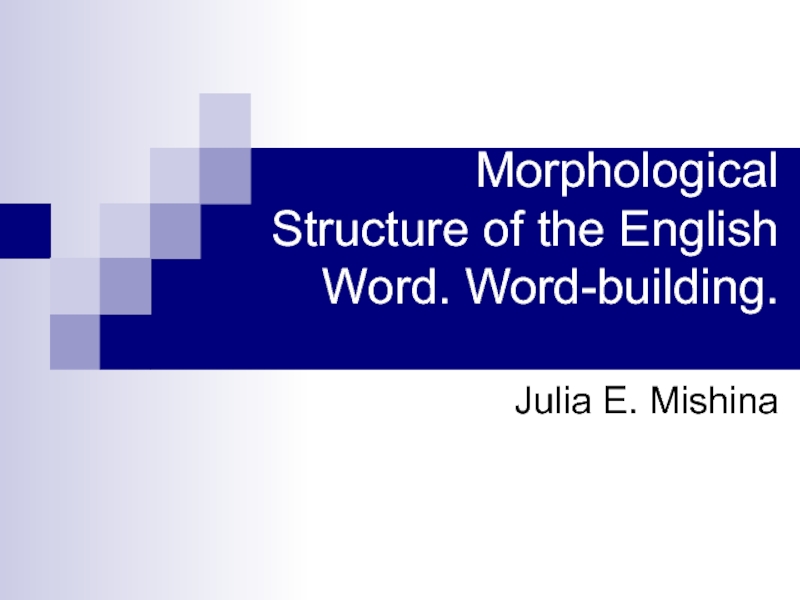
Слайд 2Points to be discussed:
Lexicology as a branch of linguistics.
Morphological structure of
the English word.
Word formation:
Affixation.
Conversion.
Compound words.
Shortening and minor types of word-building

Слайд 3
Vocabulary – the system formed by the sum total of all
the words that the language possesses.
Language – a semiological system as the main and basic means of human communication.
Word – the basic unit of the language, the unity of expression (sound form) and the content (meaning).
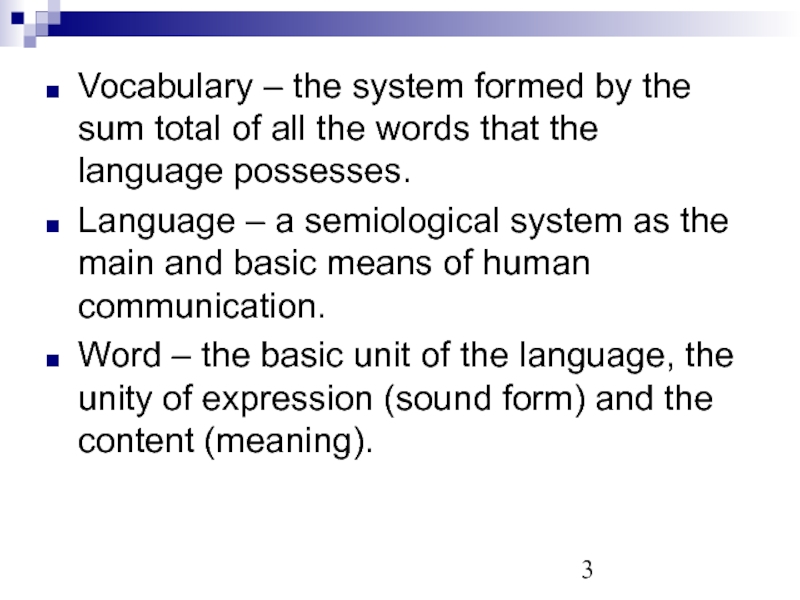
Слайд 6The place of Lexicology within Linguistics
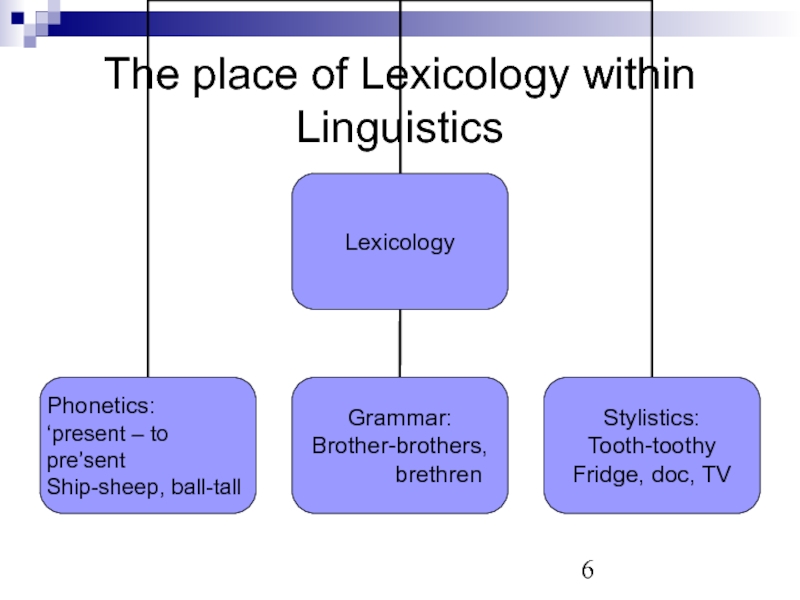
Слайд 7Practical value of Lexicology
provides the correct use of synonyms
gives basic knowledge
of word-building patterns
helps to avoid semantic calque from one’s native language
teaches to identify set-expressions, synonyms, phraseological units etc. and to translate them properly
teaches to differentiate between polysemantic words and homonyms
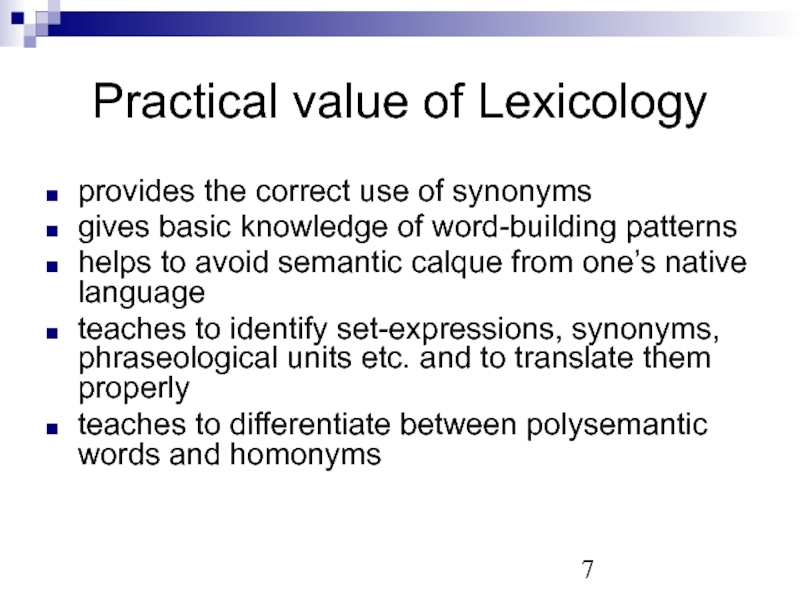
Слайд 8The size-of-unit problem
The fox hid in the fox-hole.
(Common Case —
Singular)
Grammatical whole-formedness
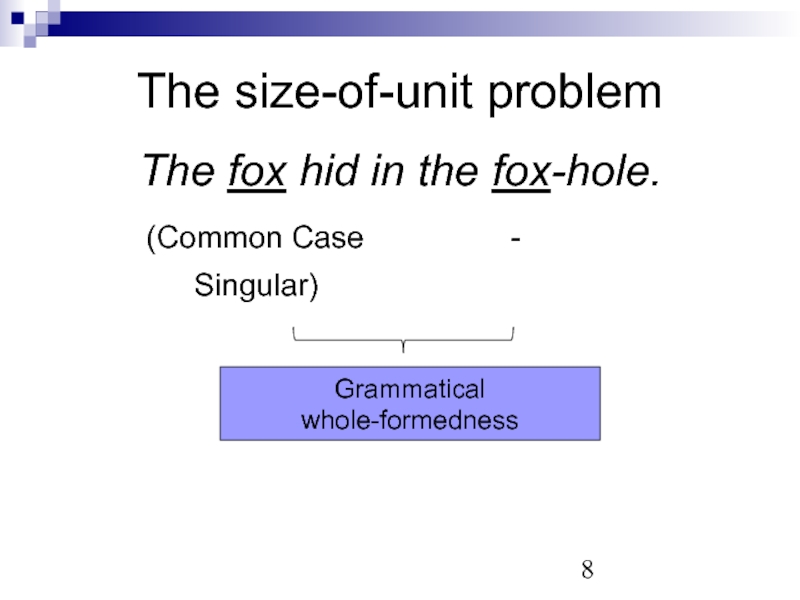
Слайд 9The identity-of-unit problem
Variants of the word:
phonetic
automatic: a book – an apple
accentual:
‘territory – terri’tory
emic: direct [di’rekt, dai’rekt]
morphological: grammatical: learn-learned, learnt
lexical: stylistic – stylistical
semantic: sweet tea – a sweet voice
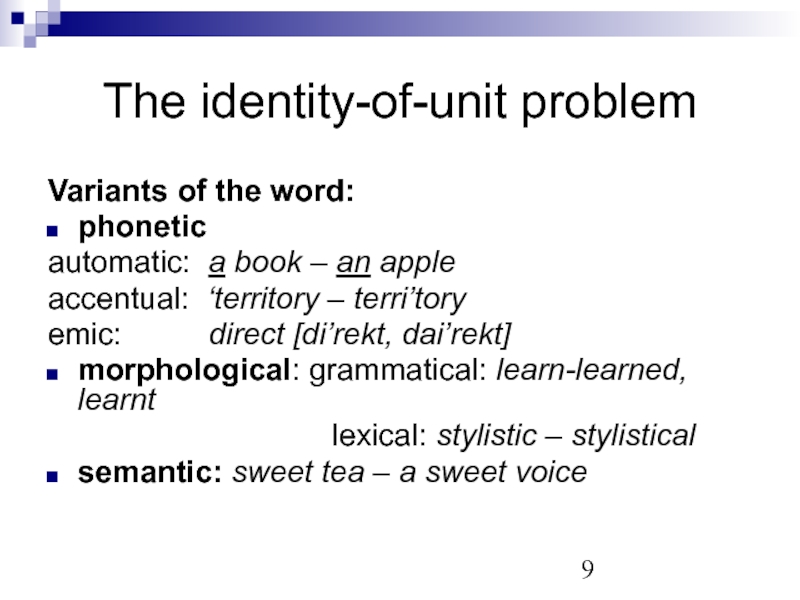
Слайд 11The two aspects of lexical morphology
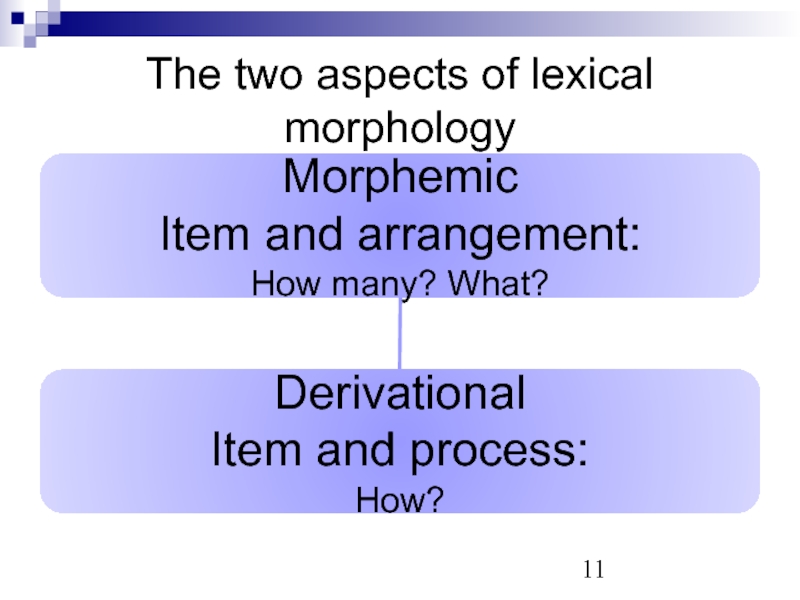
Слайд 12Structural types of words
Simple (root)
Derived stems (derivatives)
Compound stems
Compound derivatives
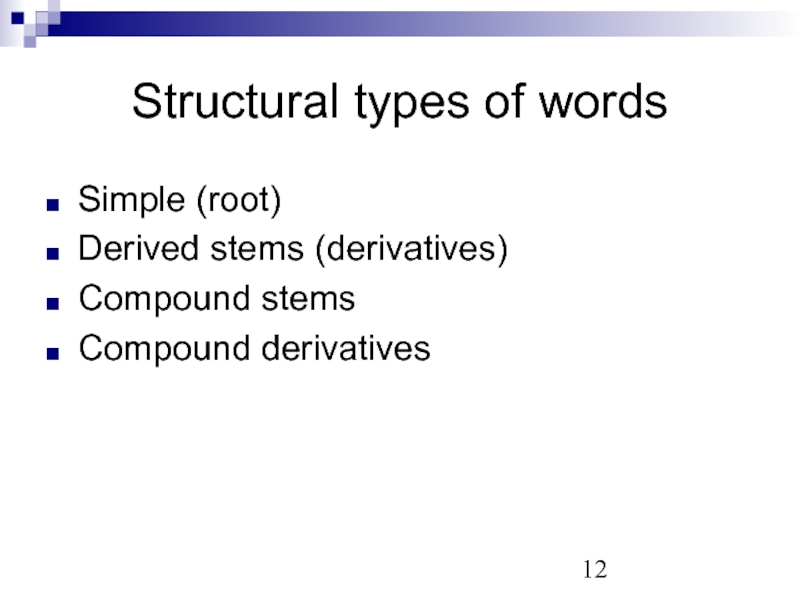
Слайд 13‘One-way’ and ‘two-way’ segmentability of the word
beautiful
beauty careful
beauteous wonderful
to beautify hopeful
beautician, etc. plentiful, etc.
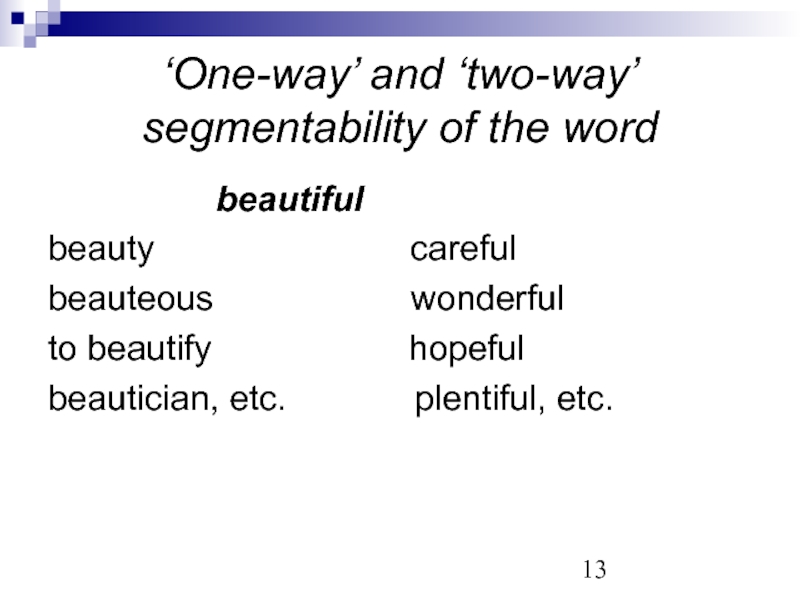
Слайд 14Lexical-morphological categories
The lexical-morphological categories are those categories of the most general
character which are realized in the semantic opposition according to a certain distinctive feature of two or more words on condition that the same opposition finds systematic expression.
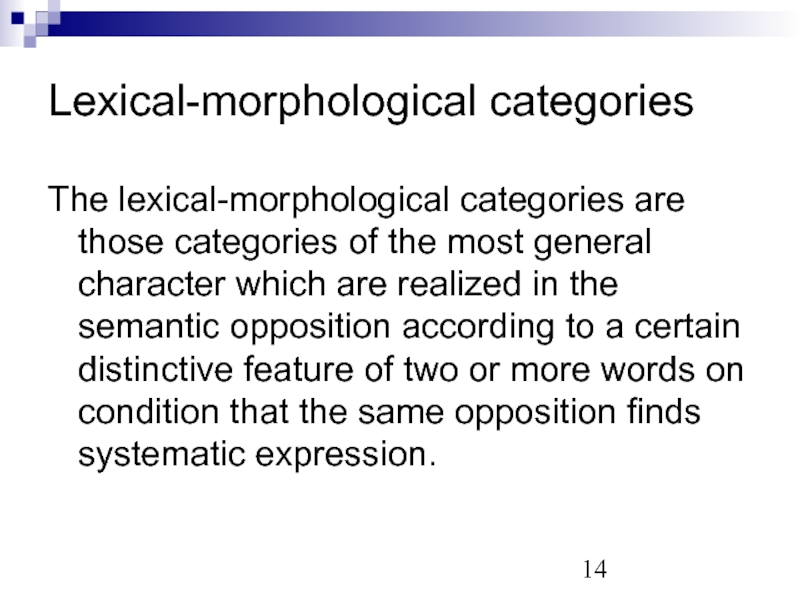
Слайд 15Lexical-morphological categories
lexical morphological category of quality: black – blackness, dark –
darkness, quiet – quietness, happy – happiness
lexical morphological category of action-agent: to do – doer, to read – reader, to manage – manager, to go – goer, to combine –combiner, to intrude – intruder
lexical morphological category of caritivity : friend – friendless, faith – faithless, rest – restless, tree – treeless, expression – expressionless
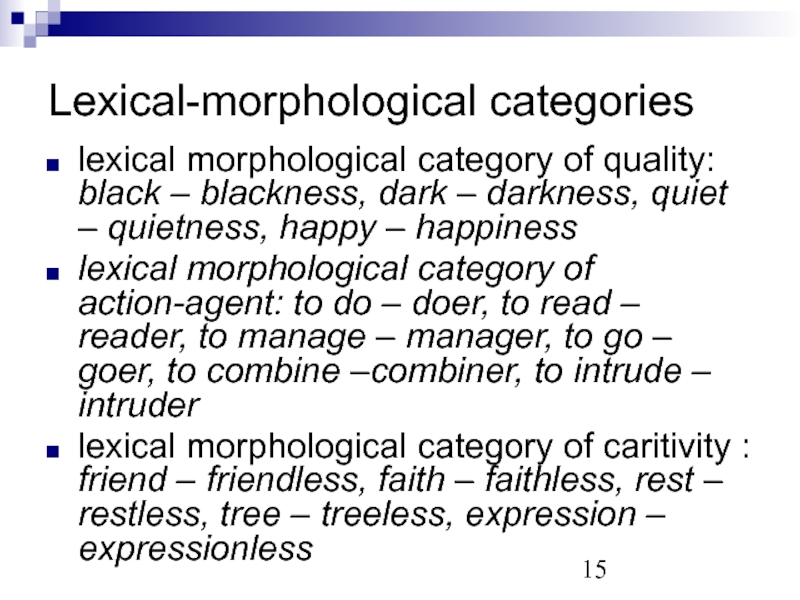
Слайд 16(to) drive + er = driver (n)
Structural pattern:
Verb stem +
”er”suffix(noun forming)= noun
Semantic pattern:
Action + “agent of action” = profession
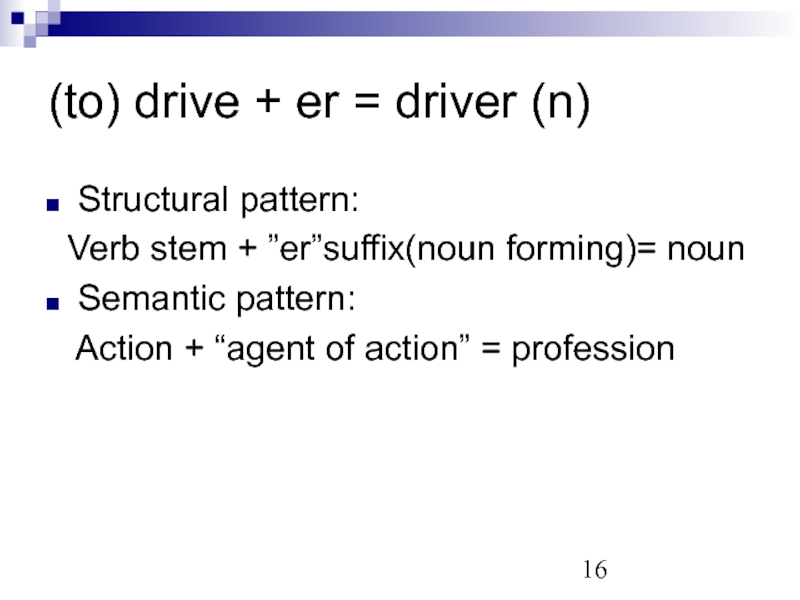
Слайд 18Affixation – forming a word by combining a stem and derivational
affixes
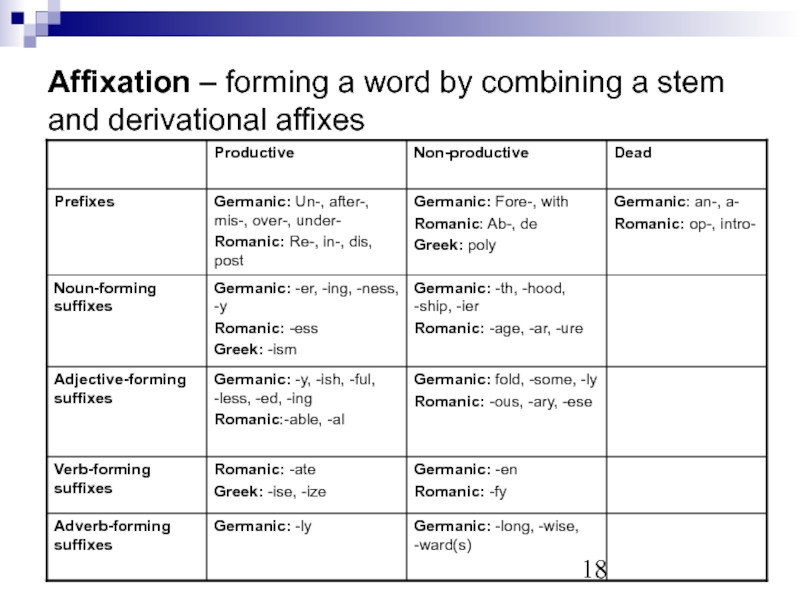
Слайд 19Conversion- a special type of derivation in which the word-forming means
is the paradigm of the word
Semantic changes which accompany conversion:
N – a tool, V – an action performed by it;
N — an animal, V – typical behavior;
N – a profession, V – typical activity;
N – a container, V – the process of occupying this container;
N – period of time, V – presence somewhere within this period;
N – a meal, V – the process of taking it.
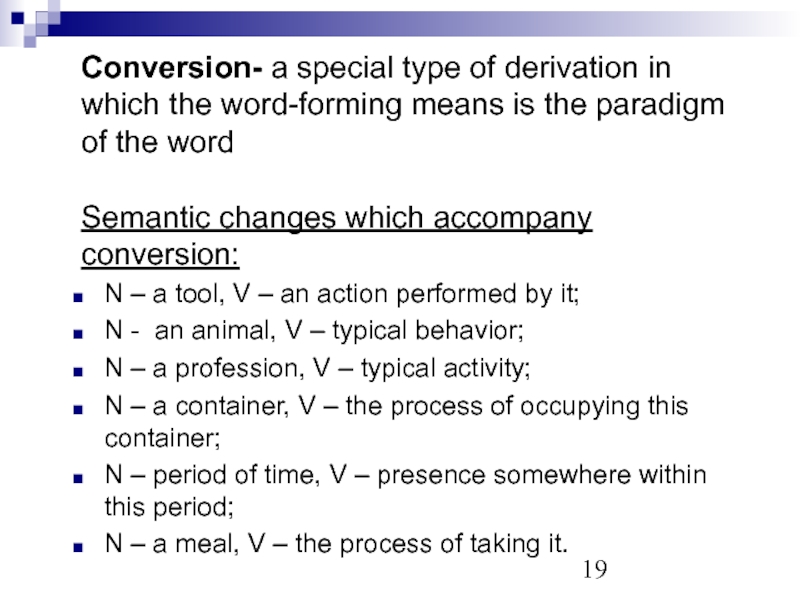
Слайд 20Composition – forming a word by combining two or more stems
Structural
classification of compounds
Neutral: bedroom, snowfall
Morphological: speedometer, Afro-Asian, statesman
Syntactical (lexicalized phrases): son-in-law, pepper-and-salt, with a devil-may-care expression on his face, his next what’s-her-name, A.Christie’s famous whodunit
Derivational: blue-eyed, writing table
Contracted: math-mistress, V-day, H-bag
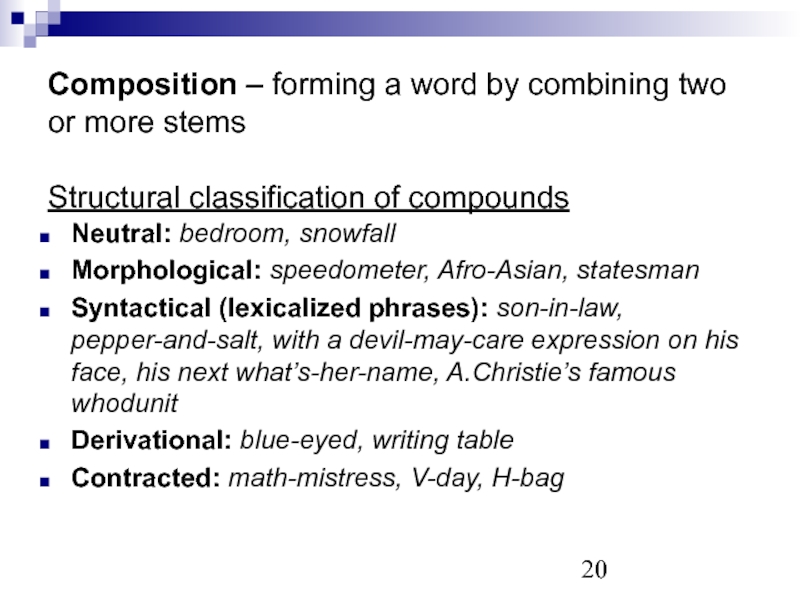
Слайд 21Semantic classification of compounds
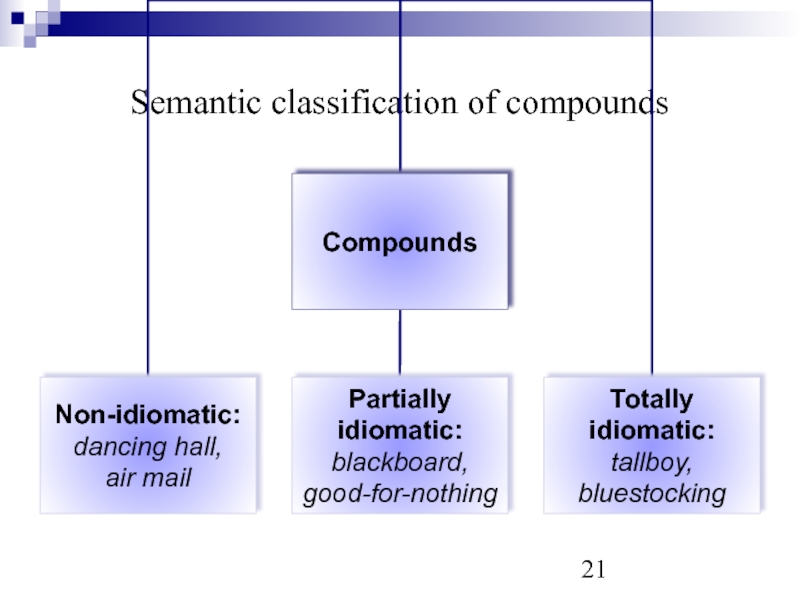
Слайд 22Criteria for differentiating a compound from a word-combination
Semantic: a compound denotes
one notion
Phonetic: a compound has unifying stress
Morphological: a compound is characterized by a single grammatical framing
Syntactic: a compound can’t be enlarged
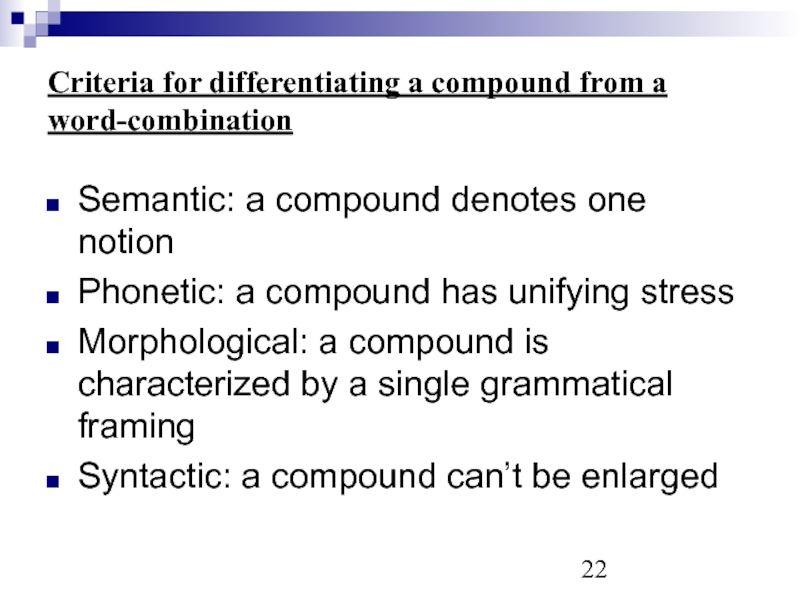
Слайд 23Shortening — the process of substituting a part for a whole
Clipping
– cutting off of a part of a word to one or two syllables
Abbreviation – forming a word out of the initial elements of a word-combination
Blending – combining parts (but not morphemes) of two words to form one word
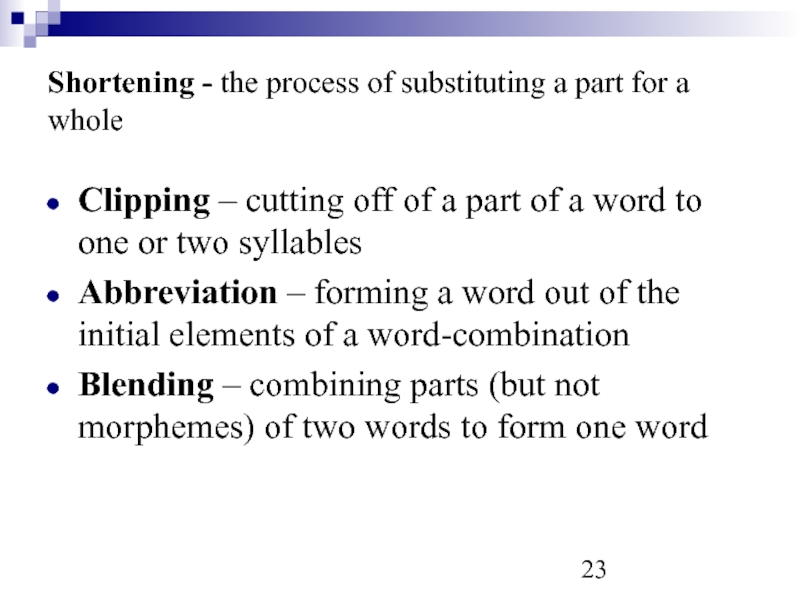
Слайд 24Minor types of word-building
Sound and stress interchange
Sound imitation
Reduplication
Back-formation
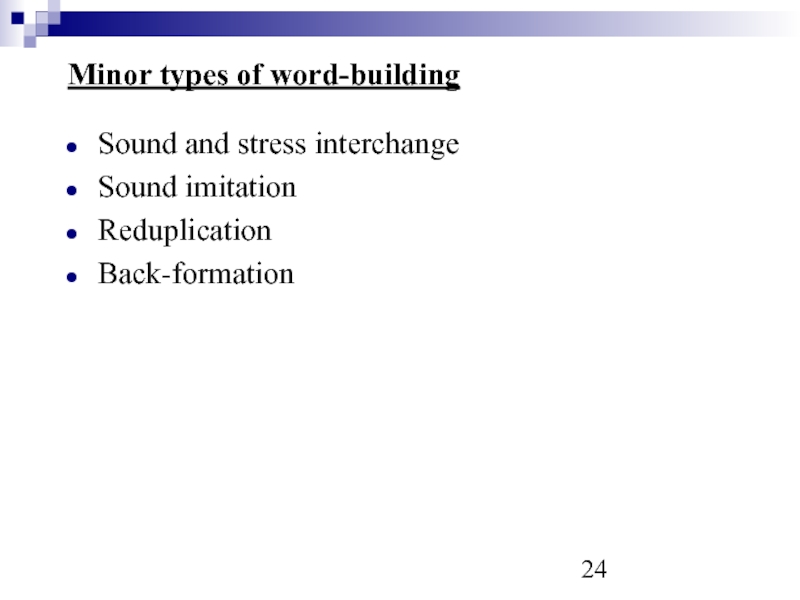
Слайд 1
Описание слайда:
Morphological Structure of the English Word. Word-building.
Julia E. Mishina
Слайд 2
Описание слайда:
Points to be discussed:
Lexicology as a branch of linguistics.
Morphological structure of the English word.
Word formation:
Affixation.
Conversion.
Compound words.
Shortening and minor types of word-building
Слайд 3
Описание слайда:
Vocabulary – the system formed by the sum total of all the words that the language possesses.
Language – a semiological system as the main and basic means of human communication.
Word – the basic unit of the language, the unity of expression (sound form) and the content (meaning).
Слайд 4
Описание слайда:
Branches of Lexicology
Слайд 5
Описание слайда:
Branches of Lexicology
Слайд 6
Описание слайда:
The place of Lexicology within Linguistics
Слайд 7
Описание слайда:
Practical value of Lexicology
provides the correct use of synonyms
gives basic knowledge of word-building patterns
helps to avoid semantic calque from one’s native language
teaches to identify set-expressions, synonyms, phraseological units etc. and to translate them properly
teaches to differentiate between polysemantic words and homonyms
Слайд 8
Описание слайда:
The size-of-unit problem
The fox hid in the fox-hole.
(Common Case —
Singular)
Слайд 9
Описание слайда:
The identity-of-unit problem
Variants of the word:
phonetic
automatic: a book – an apple
accentual: ‘territory – terri’tory
emic: direct [di’rekt, dai’rekt]
morphological: grammatical: learn-learned, learnt
lexical: stylistic – stylistical
semantic: sweet tea – a sweet voice
Слайд 10
Описание слайда:
Classification of morphemes
Слайд 11
Описание слайда:
The two aspects of lexical morphology
Слайд 12
Описание слайда:
Structural types of words
Simple (root)
Derived stems (derivatives)
Compound stems
Compound derivatives
Слайд 13
Описание слайда:
‘One-way’ and ‘two-way’ segmentability of the word
beautiful
beauty careful
beauteous wonderful
to beautify hopeful
beautician, etc. plentiful, etc.
Слайд 14
Описание слайда:
Lexical-morphological categories
The lexical-morphological categories are those categories of the most general character which are realized in the semantic opposition according to a certain distinctive feature of two or more words on condition that the same opposition finds systematic expression.
Слайд 15
Описание слайда:
Lexical-morphological categories
lexical morphological category of quality: black – blackness, dark – darkness, quiet – quietness, happy – happiness
lexical morphological category of action-agent: to do – doer, to read – reader, to manage – manager, to go – goer, to combine –combiner, to intrude – intruder
lexical morphological category of caritivity : friend – friendless, faith – faithless, rest – restless, tree – treeless, expression – expressionless
Слайд 16
Описание слайда:
(to) drive + er = driver (n)
Structural pattern:
Verb stem + ”er”suffix(noun forming)= noun
Semantic pattern:
Action + “agent of action” = profession
Слайд 17
Описание слайда:
Word-building patterns
Слайд 18
Описание слайда:
Affixation – forming a word by combining a stem and derivational affixes
Слайд 19
Описание слайда:
Conversion- a special type of derivation in which the word-forming means is the paradigm of the word
Semantic changes which accompany conversion:
N – a tool, V – an action performed by it;
N — an animal, V – typical behavior;
N – a profession, V – typical activity;
N – a container, V – the process of occupying this container;
N – period of time, V – presence somewhere within this period;
N – a meal, V – the process of taking it.
Слайд 20
Описание слайда:
Composition – forming a word by combining two or more stems
Structural classification of compounds
Neutral: bedroom, snowfall
Morphological: speedometer, Afro-Asian, statesman
Syntactical (lexicalized phrases): son-in-law, pepper-and-salt, with a devil-may-care expression on his face, his next what’s-her-name, A.Christie’s famous whodunit
Derivational: blue-eyed, writing table
Contracted: math-mistress, V-day, H-bag
Слайд 21
Описание слайда:
Semantic classification of compounds
Слайд 22
Описание слайда:
Criteria for differentiating a compound from a word-combination
Semantic: a compound denotes one notion
Phonetic: a compound has unifying stress
Morphological: a compound is characterized by a single grammatical framing
Syntactic: a compound can’t be enlarged
Слайд 23
Описание слайда:
Shortening — the process of substituting a part for a whole
Clipping – cutting off of a part of a word to one or two syllables
Abbreviation – forming a word out of the initial elements of a word-combination
Blending – combining parts (but not morphemes) of two words to form one word
Слайд 24
Описание слайда:
Minor types of word-building
Sound and stress interchange
Sound imitation
Reduplication
Back-formation
1
Etymology of the English Word- stock Etymology (Gr. etymon truth + Gr. logos learning) is a branch of linguistics that studies the origin and history of words tracing them to their earliest determinable source.
2
The Origins of English Words English words NativeBorrowed
3
Definitions A native word is a word which belongs to the original English word stock, as known from the earliest available manuscripts of the Old English period. A borrowed word (a borrowing, or a loan word) is a word taken over from another language and modified in phonemic shape, spelling, paradigm or meaning according to the standards of the English language.
4
Words of Native Origin Words of the Indo-European origin (IE) Words of common Germanic origin English words proper
5
Words of the Indo-European origin Family relations: father, mother, brother, son, daughter Parts of the human body: foot, nose, lip, heart, tooth Animals and plants: cow, swine, goose, tree, birch, corn The most important objects and phenomena of nature: sun, moon, star, wind, water, wood, hill, stone Adjectives: hard, quick, slow, red, white, new Numerals from 1 to 100: one, two, twenty, eighty Pronouns – personal, except they (Sc.): I, you, he; demonstrative : that; interrogative: who Some of the most frequent verbs: bear, do, be, sit, stand
6
Words of common Germanic origin Nouns denoting parts of the human body: head, arm, finger Periods of time: summer, winter, time, week Natural phenomena: storm, rain, flood, ice, ground, sea, earth Artefacts and materials: bridge, house, shop, room, coal, iron, lead, cloth Animals, plants and birds: sheep, horse, fox, crow, oak, grass Adjectives denoting colours, size and other properties: broad, dead, deaf, deep, grey, blue Verbs: see, hear, speak, tell, say, make, give
7
Historical causes of borrowing The Roman invasion (1 st c. B.C.), The introduction of Christianity (7 th c. A.D.), The Danish conquests (11 th – 13 th c. A.D.), The Norman conquest (1066 A.D.), The Renaissance period (14 th – 16 th c. A.D.), Direct linguistic contacts and political, economical and cultural relationship with other nations.
8
The Etymology of Borrowed Words Celtic: 5 th – 6 th A. D. Latin: 1 st layer: 1 st c. B. C. 2 nd layer: 7 th c. A. D. (the introduction of Christianity) 3 rd layer: 14 th – 16 th c. (the Renaissance period) Scandinavian: 8 th – 11 th c. A. D. French: Norman borrowings: 11 th – 13 th A. D. Parisian borrowings: the Renaissance period Greek: the Renaissance period Italian: the Renaissance period and later Spanish: the Renaissance period and later Russian: the Renaissance period and later German, Indian and other languages
9
Celtic borrowings Place names: Avon, Exe, Esk, Usk, Ux (Celtic river, water); London (Llyn river+ dun a fortified hill) — a fortress on the hill over the river cradle, cross, iron, flannel, tweed, lake (C. loch)
10
The earliest Latin borrowings (1 st c. A.D.) words denoting things connected with war, trade, building and domestic life: pound, inch, cup, kitchen, pepper, butter, cheese, milk, wine, cherry
11
Latin words borrowed into English through the Christianization of England (7 th c. A.D.) persons, objects and ideas associated with church and religious rituals: priest, bishop, monk, nun, candle, temple, angel words connected with learning: grammar, school, scholar, decline, master, magister
12
Latin borrowings of the Renaissance period (14 th – 16 th c. A.D.) abstract words: major, minor, filial, moderate, intelligent, permanent, to elect, to create.
13
Scandinavian borrowings (8 th — 11 th c. A.D.) Verbs: call, take, cast, die, want Nouns: law, egg, husband (Sc. hūs + bōndi inhabitant of the house), window (Sc. vindauga the eye of the wind) Adjectives: ill, loose, low, weak Pronouns and pronominal forms: they, their, them, same, both, though.
14
Scandinavian borrowings (place names) Derby, Tremsby (-by: Sc. village, town); Zinthorp, Altharp (-thorp: Sc. village); Eastoft, Nortoft (-toft: Sc. a plot of land covered with grass); Troutbeck (-beck: Sc. brook); Inverness (-ness: Sc. cape); Applethwait, Crossthwait (-thwait: Sc. forest glade)
15
Norman borrowings (11 th – 13 th c. A.D.) Government and administration: state, country, government, parliament, prince, baron Legal terms: court, judge, justice, crime, prison, jury Religious terms: saint, sermon (проповедь), prayer, parish (приход), chapel Military terms: army, war, soldier, officer, battle, enemy Educational terms: pupil, lesson, library, science, pen, pencil Artistic and literary terms: image, character, figure, volume, design Terms of everyday life: chair, table, plate, saucer, dinner, supper, breakfast
16
Parisian borrowings: the Renaissance period and later regime, routine, police, machine, ballet, matinée, scene, technique, bourgeois, etc.
17
The Renaissance period borrowings (14 th – 16 th c. A.D.) Italian: piano, violin, opera, alarm, colonel Spanish: potato, tomato, cargo, banana, cocoa. Greek: direct (e.g. atom, cycle, ethics, esthete), or through Latin (datum, status, phenomenon, phenomenon, philosophy, method, music).
18
Other borrowings Japanese: karate, judo, hara-kiri, kimono, tycoon; Arabic: algebra, algorithm, fakir, giraffe, sultan Turkish: yogurt, kiosk, tulip Persian: caravan, shawl, bazaar, sherbet Eskimo: kayak, igloo, anorak Amerindian languages: toboggan, wigwam, opossum Russian: bistro, tsar, balalaika, tundra, sputnik
19
Classification of borrowings according to the aspect which is borrowed Borrowings proper Translation borrowings (translation loans) Semantic borrowings
20
Classification of borrowings according to the aspect which is borrowed Translation borrowings (translation loans) are words and expressions formed from the material already existing in the English language but according to patterns taken from another language, by way of literal morpheme-for-morpheme translation. E. g. masterpiece < Germ. Meisterstück; Wonder child < Germ. Wunderkind; wall newspaper < Rus. стенная газета; collective farm < Rus. колхоз.
21
Classification of borrowings according to the aspect which is borrowed Semantic borrowing is understood as the development in an English word of a new meaning under the influence of a related word in another language. E. g. Eng. pioneer explorer, one who is among the first in new fields of activity:: Rus. пионер a member of the Young Pioneers Organization. reaction, deviation, bureau
22
International words Words of identical origin that occur in several languages as a result of simultaneous or successive borrowings from one ultimate source (I. A. Arnold, p. 260).
23
International words Words denoting science and technological advances: sputnik, television, antenna, bionics, gene, cybernetics Political terms: politics, democracy, communism, revolution Fruits and foodstuffs imported from exotic countries: coffee, chocolate, grapefruit Names of sciences: philosophy, mathematics, physics, chemistry Terms of art: music, theatre, drama, tragedy The sports terms: football, baseball, cricket, golf.
-
Скачать презентацию (0.25 Мб)
-
163 загрузки -
3.7 оценка
Ваша оценка презентации
Оцените презентацию по шкале от 1 до 5 баллов
- 1
- 2
- 3
- 4
- 5
Комментарии
Добавить свой комментарий
Аннотация к презентации
Посмотреть и скачать презентацию по теме «Modern English Word Formation» по иностранным языкам, включающую в себя 26 слайдов. Скачать файл презентации 0.25 Мб. Средняя оценка: 3.7 балла из 5. Большой выбор учебных powerpoint презентаций по иностранным языкам
-
Формат
pptx (powerpoint)
-
Количество слайдов
26
-
Слова
-
Конспект
Отсутствует
Содержание
-
Слайд 1
Modern
English
Word
Formation -
Слайд 2
The aim of this work is to teach students to be word-conscious, to be able to guessthe meaning of words they come across from the meaning of morphemes, to beable to recognize the origin of this or that lexical unit.
The task of the work is to show the ways of word building, i.e. affixation,suffixation, compounds, statives, vowel and consonant alternations and conversion.
Topical interest. This work is of topical interest because English is a livinggrowing language. The system of its sounds is subjected to various changes, thewords and word combinations undergo changes. The most noticible and mostappreciable transformations occur in words that form part of English, that is in itsvocabulary. -
Слайд 3
It is a matter of common knowledge that the vocabulary of any language is never stable, but is constantly changing, growing and decaying. The changes in the vocabulary of the language are due both to linguistic and extra-linguistic causes, which are determined by the social nature of the language.The intense development of science and technology has lately given birth to a great number of new words such as ‘computer’, ‘cyclotron’,’radar’, ‘psycholinguistics’, etc.; the conquest and research of outer spacestarted by the Soviet people contributed words like ‘sputnik’,‘lunokhod’,’babymoon’,’moon-car’,’spaceship’. It is significant that the suffix –nik occurring in the noun‘sputnik’ is freely applied to new words of various kinds, e.g. ‘flopnik’,’mousenik’, ‘woofnik’,etc.
-
Слайд 4
The ways in which new words are formed, and the factors which govern their acceptance into the language, are generally taken very much for grantedby the average speaker to understand a word, it is necessary to know how it is constructed, whether it is simple or complex, that is whether ornot it can be broken down into two or more parts.We are able to use a word which is new to us when we find out what object or notion it denotes. Somewords, of course, are more understandable than others.
-
Слайд 5
Unfathomable =negative prefix + adjective forming suffix =cannot be fathomed.Knowing the pattern, we can easily guess the meaning of a word although there are lots of other words which look similar, for instance, unfashionable and unfavourable for which this analysis will not work. We accept as quite natural the fact that although we can use the verbs ‘to pipe’, ‘to drum’ and ‘to trumpet’, we cannot use the verbs ‘to piano’ and ‘to violin’.
-
Слайд 6
An unabridged English dictionary contains about 600 000 words
The bad news is that even if you have an
excellent vocabulary, you know only a
small percentage of those words. The good
news, however, is that you can increase
your vocabulary throughout your life. The
even better news is that once you have
learnt a new word, it is yours for life. It will
always be stored away, ready to be recalled
the next time you have a conversation or
write a letter or composition. -
Слайд 7
Some words have many different meanings.
Let’s take, for example, the
word ‘titanic’ in the following
sentences. 1. The Titanic sank in
the North Atlantic on an April
night in 1912 after hitting an
iceberg. 2. The enemies were
locked in a titanic struggle. You
can tell from the first sentence
that Titanic is a ship and from the
second sentence that ‘titanic’
means “having great size, force
or power. -
Слайд 8
Context clues can help us learn the meaning of a word. The context of a word is the sentence, the surrounding words, or the situation in whichthe word appears.There are several types of them.1. Definition or restatement is defined in the sentence ,e.g.We read a collection of fables, short stories that teach a lesson.2. The meaning of the word is made clear by the example, e.g.Bombay is a populous city; one way the Indian government hastried to ease the overcrowding there is to build a second Bombay.3. Comparison. e.g. Joseph has always been amiable – almost as friendly as his older brother Mark.( As introduces a comparison between Joseph’s disposition and that of his older brother.)4. Contrast. e.g. The mayor’s popularity, soared to its highest point,but the city council’s dropped to its nadir. ( A contrast is drawnbetween the highest point of the mayor’s popularity and the lowest point, the nadir, of the city council’s.
-
Слайд 9
Means of word-forming
English is a living, growing language; new words are
constantly being added. English words come from many
sources. Some come from the dead language Latin, and
others come from ancient Greek. Knowing the words and
parts of words borrowed from Latin and Greek can help us
understand the meaning of many English words. In general,
English words are of two kinds:
those that can be
analysed into smaller
parts:
untimelythose that cannot
time, face, feel -
Слайд 10
The words of the first kind, which can be divided, are made up of parts called
prefixes
roots
suffixes
They offer clues
to the meaning of the words.
A root
is the part of a word
that carries the basic meaning.
A prefix
is one or more syllables
placed in front
of the root to modify the meaning of the root
or to form a new word. -
Слайд 11
PREFIXES HAVE BROAD GENERAL MEANINGS LIKE‘NOT’, ‘UNDER’, ‘AGAINST’ AND ANY OF THEM MAY APPEARIN HUNDREDS OF DIFFERENT WORDS. BECAUSE PREFIXESOFTEN HAVE MORE THAN ONE MEANING, THEY CAN BE HARD TO INTERPRET.
The main function of prefixes
is to change
the lexical meaning of the same part of speech.
There are 51 prefixes in the system of Modern English word formation.
Prefixation -
Слайд 12
Suffixation
In Modern English, suffixation is mostly characteristic of noun and adjectiveformation, while prefixation is mostly typical of verb formation. The distinction alsorests on the role different types of meaning play in the semantic structure of thesuffix and the prefix. The part-of -speech meaning has a much greater significancein suffixes as compared to prefixes which possess it in a lesser degree.Due to it, a prefix may be confined to one part of speech as, for example,enslave,encage, unbutton ,or may function in more than one part of speech asover- inover kind, overfeed, overestimation.
Unlike prefixes, suffixes as a rule function in any one part of speech often forming
a derived stem of a different part of speech as compared with that of the base,e.g. careless — care; suitable — suit, etc. Furthermore, it is necessary to point outthat a suffix closely knit together with a base forms a fusion retaining less of itsindependence that a prefix which is as a general rule more independent semantically,e.g. reading- ‘the act of one who reads’; ‘ability to read’; andre-read — ‘to read again’. -
Слайд 13
There are two kinds of suffixes:
Grammatical Derivational
-s, -ed, -ing
-ly,-ence,ize,-hood
grammatical provide a grammatical signal of some kind but don’t greatlyalter the basic meaning of the word and those that, by being added, createnew words. The endingsare suffixesof the first kind. Grammatical suffixes are important in grammar, but in vocabulary we are more concerned with the second kind of suffixes –those that make new words – derivational suffixes. -
Слайд 14
Derivational suffixes can be classified according to the parts of speech.
Classification of suffixes
-
-
Слайд 16
Adjective suffixes
-
-
Слайд 18
Suffixes indicating smallness or lessening
-
Слайд 19
When speaking about the structure of words stems should
also be mentioned. The stem is the part of the word
which remains unchanged throughout the paradigm
of the word.Stems have not only the lexical meaning but
also grammatical meaning. They can be noun stems, adjective
stems and verb stems. Sometimes it is rather difficult to
distinguish between simple and derived words, especially in
the cases of phonetic borrowings from other languages and
of native languages with blocked morphemes, e.g. “cranberry”,
“absence”,etc.Roots
-
Слайд 20
Compound nouns are nouns built from two or more roots.
They often have one stress. The meaning of a compound
often differs from the meaning of its elements.
Compounding- is one of the productive types of word-formation in Modern English.
Compound words are inseparable vocabulary units.
They are formally and semantically dependent on the
constituent bases and the semantic relations between them
which mirror the relations between the motivating units.
The main types of compound nouns are as follows:Compounds
noun-stem+noun -stem
apple-tree, snowball, newspaper
adjective stem+ noun stem
blackbird, whitehorn, blackleg -
Слайд 21
Stonewall combinations
In Modern English there are lots of word combinations of the type price rise, wage freeze, steel helmet, sand castle.
Grammarians can’t come to the conclusion whether adjectives can be formed by means of conversion from nouns. -
Слайд 22
Abbreviations
The causes of shortening can be linguistic and extra-linguistic. Abbreviation doesn’t change the part-of-speech meaning.
Examples: prof=professor, to rev=to revolve, comfy=comfortable. -
Слайд 23
Such words as asleep, abed, ablaze, afraid, akin, alive have
been named adjectives, though they can’t
be attributes in a sentence, and though their meaning
doesn’t seem to be that of property. The a- means on,
in or at. Statives are invariable. They often show a
temporary state rather than a permanent one. They
most usually follow a link-verb (was asleep) or they
can be used like a participle, but they can’t go before
the noun they modify. In the sentence a stative is most
usually a predicative (he fell asleep).
The statives -
Слайд 24
Conversion, one of the principal ways of forming words in Modern
English is highly productive in replenishing the English word-stock
with new words. This term refers to the numerous cases of words
belonging to different parts of speech. This may be illustrated by
the following cases: work – to work; love – to love; paper –
to paper. As a rule we deal with simple words. There is a certain
difference on the morphological level between various parts of
speech, mostly between nouns and verbs. What serves a word-
building means? The answer is a paradigm. As it is a morphologi-
cal category, conversion can be described as a morphological
way of forming words.Conversion
-
Слайд 25
Blends are words formed from a word-group or two synonyms.
In blends two ways of word-building are combined: abbreviation
and composition. To form a blend we clip the end of the first
component and the beginning of the second component. As a
result we have a compound –shortened word. One of the first
blends in English was the word “smog” from two synonyms:
smoke and fog. Mostly blends are formed from a word-group:cinemadict
informecial
slimnastics
slanguist
dramedy
faction
medicare
socialite
acromania
chunnel
megalog
Blends -
Слайд 26
Cinemadict – cinema addict,informecial – informational commercialslimnastics – slimming gymnasticsslanguist – slang linguistacromania – acronym maniachunnel – channel, canalmegalog – magazine cataloguedramedy – drama comedyfaction – fact fiction – fiction based on real factsmedicare – medical caresocialite – social elite
Посмотреть все слайды
Сообщить об ошибке
Похожие презентации









Спасибо, что оценили презентацию.
Мы будем благодарны если вы поможете сделать сайт лучше и оставите отзыв или предложение по улучшению.
Добавить отзыв о сайте







Презентацию на тему «English words»
можно скачать абсолютно бесплатно на нашем сайте. Предмет
проекта: Иностранный язык. Красочные слайды и иллюстрации помогут вам
заинтересовать своих одноклассников или аудиторию.
Для просмотра содержимого воспользуйтесь плеером, или если вы хотите скачать доклад — нажмите на
соответствующий текст под плеером. Презентация
содержит 7 слайд(ов).
Слайды презентации
Слайд 2
Translate into Russian
1) I’m having a good time 2) Have a great time 3) Go for a run 4) Go for a picnic 5) Go sightseeing 6) Go skiing 7) Go and see a film 
11) I had a terrible time 12) I had a bad time 13) Go for a walk 14) Go for a meel in a restaurant 15) Go shopping 16) go swimming 17) Go and watch a match 18) Go and buy something 19) Go to a party 20) Go to a meeting
Слайд 3
Translate into English
1) Пойти на встречу 2) Идти на вечеринку 3) Пойти что-нибудь купить 4) Посмотреть матч 5) Плавать 6) Ходить по магазинам 7) Поесть в ресторане 
11) Я хорошо провожу время 12) Счастливо! 13) Пробежаться 14) Съездить на пикник 15) Осматривать достопримечательности 16) Кататься на лыжах 17) Посмотреть фильм 18) Сходить к другу 19) Идти на свадьбу 20) Пойти на дискотеку
Слайд 4
a) Поесть в ресторане b) Я хорошо провожу время c) Съездить на пикник d) Прогуляться e) Я ужасно провёл время f) Плавать g) Ходить по магазинам h) Пойти на дискотеку i) Осматривать достопримечательности j) Посмотреть фильм
1) Go for a walk 2) Go swimming 3) I’m having a good time 4) Go to a disco 5) Go and see a film 6) Go sightseeing 7) I had a terrible time 
Match the expressions to others with similar meanings
Слайд 5
11) Желаю хорошо провести время 12) Пробежаться 13) Кататься на лыжах 14) Посмотреть матч 15) Сходить к другу 16) Пойти на встречу 17) Идти на вечеринку 18) Пойти что-нибудь купить 19) Идти на свадьбу 20) Я плохо провёл время
a) Go to a wedding b) Have a great time! c) Go and see a friend d) Go skiing e) I had a bad time f) Go to a party g) Go and watch a match h) Go and buy something i) Go to a meeting j) Go for a run
Слайд 6
1) FALSE — watch 2) FALSE — disco 3) TRUE 4) TRUE 5) FALSE — sightseeing 6) FALSE — friend 7) TRUE 
1) Go and wotch a match 2) Go to a disko 3) Go shopping 4) Go for a picnic 5) Go sightseeng 6) Go and see a frend 7) Go to a party 8)I had a terible time 9) Go skiing 10) Go for a meel in a restaurant
Is it True or False?
Список похожих презентаций

We are lucky to learn English
Brainstorming ideas. Do you think it is important to know English? Why? How can we use it? What are, in your opinion, some of the best ways of learning …

Брейн-ринг «We love English»
Contest 1. Team Presentation The first contest is team presentation. Your task is: -choose a leader -present the name of your team -present the emblem …
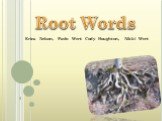
Root Words
PREFIX “Arthro-” Indicating a joint Examples:. Arthropod — a invertebrate having jointed limbs and a segmented body with an exoskeleton made of chitin. …

Phrasal verbs in English
Make up. Think of over. Put on off in. Turn out up. Get through Pass Call Break Finish Cope. Go into. Интернет-ресурсы: Рамка нежная http://img-fotki.yandex.ru/get/6520/16969765.99/0_6a837_8225efc1_L.png …

PRESENTATION IN ENGLISH TORNADO
A tornado is a violently rotating column of air that is in contact with both the surface of the earth and a cumulonimbus cloud or, in rare cases, …

My Favourite English writer
Charlotte Brontё. Charlotte Brontё an English novelist of the 19th century, was a contemporary of Dickens,Thackeray and Geskell. Biography. She was …

Easy English
Эксперимент по проблеме:. «Формирование элементарных навыков общения на иностранном языке детей в системе «Детский сад — начальная школа». разработана …

English
Лобанова Наталья Михайловна и учащиеся 7а класса приглашают Вас на урок английского языка! Why study English? Language is the most important mean …

Compound Words
What are compound words? Compound words are two words that are put together to make one word. For example, look at this word. basketball. basket is …

Colour words
l b u e. w h i t. r d. o y. n g. a c k. p. . . . …

Club of English
I would like to make a club of the English language. There could walk all the students and teachers of our school, and their relatives. I think that …

Happy English!!!
Man (Человек) Lesson 1. Head (голова) Ears (уши). Hair (волосы). Eyes (глаза) Nose (нос). Lips (губы) Teeth (зубы). Language (язык) Neсk (шея). Hand …

English Cuisine
The features of English cuisine. English cuisine includes, traditions, styles and recipes associated with England; It has distinctive attributes of …

OUR HAPPY ENGLISH
English is the best of subjects! Children study day and night. Our teachers make the wonder— Make the pupils smart and bright! Our teacher in the …
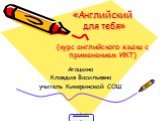
English for you
ENGLISH FOR YOU Form 6. Может ли компьютер заменить учителя? Твои школьные учебники. . Что ты научишься делать и узнаешь. Выучишь много новых слов …

Preliminary English Test
What is the PET exam? The Preliminary English Test (PET), is an English language examination provided by Cambridge English Language Assessment. Cambridge …
Конспекты

Is It necessary to Learn English?
Бойко Лилия Валерьевна. НОУ «Школа-интернат № 29ОАО «РЖД». г. Уссурийск. Учитель английского языка. Урок английского языка в 10-м классе (филологический …

We can speak English
Никитина Светлана Алексеевна. Учитель английского языка. ГБОУ СОШ 1034. Класс:. 2. . УМК «Английский с удовольствием» М.З. Биболетова. Тема …

Are you an Expert in English?
Game for. the. 5 forms: “Are you an Expert in English?”. Good morning dear guests. You are welcome to our game: “Are you an expert in English”. …

New Millennium English
Министерство образования и науки Удмуртской Республики. Управление образования Администрации г. Ижевска. Муниципальное бюджетное общеобразовательное …

English is fun!
Муниципальное бюджетное общеобразовательное учреждение средняя общеобразовательная школа № 17 станицы Выселки муниципального образования Выселковский …

Millennium English
‘New Millennium English 9’. Unit 6 Lesson 1. 11.02.20. 14. г.
Этапы. Методы и формы работы. . Оборудование. . Учитель. . …

English around us
. School. №. 204 by ALTYNSARIN. . Grade: 9 “A,B,G”. Date: 22.11.2013. Prepared by: Urazova Gulbakyt. …

English is around us
Открытый урок в 8-ом классе по теме:. “ English is around us”. Goals:. 1. To form correct speech when you answer the questions. 2.to develop …
Советы как сделать хороший доклад презентации или проекта
- Постарайтесь вовлечь аудиторию в рассказ, настройте взаимодействие с аудиторией с помощью наводящих
вопросов, игровой части, не бойтесь пошутить и искренне улыбнуться (где это уместно). - Старайтесь объяснять слайд своими словами, добавлять дополнительные интересные факты, не нужно
просто читать информацию со слайдов, ее аудитория может прочитать и сама. - Не нужно перегружать слайды Вашего проекта текстовыми блоками, больше иллюстраций и минимум текста
позволят лучше донести информацию и привлечь внимание. На слайде должна быть только ключевая
информация, остальное лучше рассказать слушателям устно. - Текст должен быть хорошо читаемым, иначе аудитория не сможет увидеть подаваемую информацию, будет
сильно отвлекаться от рассказа, пытаясь хоть что-то разобрать, или вовсе утратит весь интерес. Для
этого нужно правильно подобрать шрифт, учитывая, где и как будет происходить трансляция презентации,
а также правильно подобрать сочетание фона и текста. - Важно провести репетицию Вашего доклада, продумать, как Вы поздороваетесь с аудиторией, что скажете
первым, как закончите презентацию. Все приходит с опытом. - Правильно подберите наряд, т.к. одежда докладчика также играет большую роль в восприятии его
выступления. - Старайтесь говорить уверенно, плавно и связно.
- Старайтесь получить удовольствие от выступления, тогда Вы сможете быть более непринужденным и будете
меньше волноваться.
Информация о презентации
Ваша оценка:
Оцените презентацию по шкале от 1 до 5 баллов
Дата добавления:20 февраля 2019
Содержит:7 слайд(ов)
Поделись с друзьями:
Скачать презентацию
Презентации из категории
Смотреть советы по подготовке презентации
Изображение слайда
How do we guess the meanings of the words we have never encountered before?
Attachment:
attach (root morpheme) + — ment (suffix)
attachment – smth. you add to a document
? Attachm ea nt ?
to mean – meant // — ment N-forming suffix
the file you meant to attach to your email but did not
Изображение слайда
This is one of the central questions of lexicology: the structure of words and the ways of building new words
Lexicology studies the internal structure of words and the rules of word-formation, the formation of new words from the resources of this particular language.
Together with the borrowing, word-forming provides for enlarging and enriching the vocabulary of the language.
Изображение слайда
4
Слайд 4: Morphemes
What is the smallest meaningful unit of the language?
Sound / phoneme???
Word???
ring > ringlet
MORPHEME!
Morpheme is the minimum meaningful language unit.
Morphemes are not independent, they occur only as parts of words, although a word may consist of a single morpheme (love, house, red, cry).
Изображение слайда
5
Слайд 5: Types of words from the morphological point of view
Изображение слайда
Phonetically conditioned positional variants of a morpheme are called allomorphs.
The negative prefix in- has the following allomorphs: im — ( im possible), ir — ( ir regular), il — ( il legal).
Morphemes can be classified:
a) from the semantic point of view;
b) from the structural point of view.
Изображение слайда
Изображение слайда
Изображение слайда
9
Слайд 9: Morphemic and word-formation analysis
The procedure employed for segmenting words is morphemic analysis based on the method of Immediate and Ultimate Constituents.
This method is based on a binary principle.
At each stage two components are singled out (referred to as the Immediate Constituents (ICs)).
Each IC at the next stage of the analysis is broken into two smaller meaningful units.
The analysis is complete when we arrive at further unsegmentable units, i.e. morphemes.
They are called Ultimate Constituents (UCs).
Изображение слайда
Изображение слайда
11
Слайд 11: Structural word-formation analysis
proceeds further, studying the structural correlation with other words.
It is done with the help of the principle of oppositions, i.e. by studying the partly similar elements, the difference between which is functionally relevant.
In our case joyfully and joyful are members of a morphemic opposition.
Their distinctive feature is the suffix — ly, like in other oppositions of the same kind:
joyful dreadful beautiful
joyfully dreadfully beautifully
Observing this proportional opposition we may conclude that there is a type of derived adverbs consisting of an adjective stem and the suffix — ly.
Изображение слайда
Structural morphemic analysis is helpful in distinguishing compound words formed by composition from the ones formed by other word-formation processes.
to daydream to whitewash
composition or
composition + conversion?
day (N) + dream (N) = daydream (N) composition
daydream (N) > to daydream (V) conversion
white (ADJ) + to wash (V) = to whitewash (V) composition
Изображение слайда
13
Слайд 13: Word-formation
A characteristic feature of all human languages is the potential to create new words.
The categories of noun, verb, adjective, and adverb are open in the sense that new members are constantly being added.
The most common types of word formation are derivation (affixation), composition (compounding), conversion.
The minor types of word formation are clipping, blending, back-formation, abbreviation, sound-imitation, sound-interchange, distinctive stress.
Изображение слайда
14
Слайд 14: Affixation (Derivation)
Words which consist of a root and an affix (or several affixes) are called derived words or derivatives.
Prefixes seldom affect the basic lexico -grammatical component of the stem meaning.
A simple word and its prefixed derivative usually belong to the same part of speech:
read — re read (v); happy — un happy (adj.),
but be- + adj. > v ( be little), en- + n > v ( en case).
Suffixes mostly form a different part of speech and usually modify the lexical meaning of the base:
free (adj.) + — dom > n (free dom )
but ring (n) + -let > ring let (n)
Изображение слайда
15
Слайд 15: Classifications of affixes
according to their origin (native and borrowed)
Native suffixes: — er (work er ), — ness (loneli ness ), — ing (feel ing ), -hood (brother hood ), -ship (friend ship ), — th (tru th ), -some (hand some ), -en (dark en ), — ful (color ful )
Native prefixes: a- ( a wake)
Borrowed suffixes: -ant (deodor ant ) (Latin), (parent age ) -age, -able (read able ), — ance (clear ance ), — ard (Spani ard ) (French), — ist (lingu ist ), -ism (commun ism ) (Greek)
Borrowed prefixes: pre- ( pre historic), post- ( post war), non- ( non human), anti- ( anti aircraft) (Romanic and Greek)
Words that are made up of elements derived from different languages are called hybrids : readable
Изображение слайда
according to their semantic characteristics: polysemantic, synonymous and homonymous
Polysemantic : — у
1) composed of, full of (bon y, ston y ),
2) characterized by (rain y, cloud y ),
3) having the character of (bush y, ink y ).
Synonymous affixes:
1) doer of the action: — er, — ist, -ant (lov er, journal ist, defend ant ),
2) collectivity: -age, — dom, -(e) ry (official dom, peasant ry ),
3) diminutiveness: — ie, -lit, -ling ( bird ie, girl ie, wolf ling )
Homonymic: — ly :
1) Adj. + — ly > Adv. (quick ly ),
2) N + — ly > Adj. (love ly )
Изображение слайда
Affixes can also be classified into productive (living) and non-productive (dead).
Productive:
1) N-forming suffixes: — er, — ing, — ness (blogg ing, facebook er )
2) V-forming: — ize, -ate ( napster ize )
3) Adj.- forming: -y, — ish, — ed, -able, -less (hay-smok ed, proceed able, multitalent less )
4) Adv.-forming: — ly ( much ly )
5) Prefixes: un-, re-, dis /de- ( un follow, re tweet, de friend )
Non-productive:
1) N-forming: — th, -hood
2) Adj.-forming: — ly, -some, -en, — ous
3) V-forming: -en
Изображение слайда
18
Слайд 18: Word-composition (compounding)
Compound words are words consisting of at least two stems which occur in the language as free forms (blackbird).
Compounding is highly productive in English.
Mostly it can be found in nouns (doorstep), adjectives (wine-dark), and verbs (stage-manage).
Among noun compounds the following types can be found:
N + N > N (steamboat)
V + N > N (crybaby)
Adj + N > N (strongbox).
Compound adjectives can be of the following types:
Adj. + Adj. > Adj. (red-hot)
N + Adj. > Adj. (bloodthirsty)
N + V > Adj. (snow-covered).
Изображение слайда
The constituent members of a compound are not always equal.
Some compounds are made up of a determining (basic part = determinatum ) and a determined part (serves to differentiate the basic part = determinant ).
Thus, in steam in steamboat, red in red-hot are determinants, because steamboat is a type of boat, red-hot is a degree of hotness.
When the meaning of the compound can be inferred from its parts it is called transparent (hairbrush, bedroom, dancing-hall) and non-transparent or idiomatic, when it cannot be inferred from the meaning of components (lazybones, football).
Изображение слайда
20
Слайд 20: Criteria of differentiation b/w a compound word and a word-combination
1) Graphic — solid or hyphenated spelling
airline, air-line, air line
2) Phonological – stress
‘ice-cream (compound) vs. ‘ice ‘cream (free phrase)
but this rule does not hold with adjectives: ‘gray-‘green, ‘easy-‘going
Besides, stress can differentiate the meaning of compounds:
man’kind «the human race» and ‘mankind «men contrasted with women»
Изображение слайда
3) Semantic – a compound expresses a single idea which is not identical in meaning to the sum of the meanings of its components in a free phrase.
Tallboy does not even denote a person, but a piece of furniture
! But the semantic criterion alone cannot prove anything as phraseological units also convey a single concept.
4) Morphological – a compound is stable
a tallboy — a tall and handsome boy
a tallboy – a tallestboy
5) syntactic – a compound has one function in the sentence: There is a tallboy in the corner.
In most cases, only several criteria can convincingly classify a lexical unit as either a compound word or a word group.
Изображение слайда
Conversion is an extremely productive way of forming words in Modern English (knife — to knife, to take — a take).
It is treated differently in linguistic literature.
Some linguists define it as a morphological way of forming words ( Smirnitsky, Ginzburg ), treating conversion as the formation of a new word through changes in its paradigm.
Others (Arnold) consider it to be a morphological -syntactic word-building method, because it involves the semantic change, a change of the paradigm and a change of the syntactic function of the word.
A purely syntactic approach (functional approach) to conversion is popular with linguists in Great Britain and the USA. They define conversion as a kind of functional change.
Изображение слайда
1. Verbs converted from nouns ( denominal verbs) can express:
a) an action characteristic of the object:
ape — to ape (behave as apes do);
b) instrumental use of the object:
screw — to screw (‘fasten with a screw’);
c) acquisition or addition of the object:
fish — to fish;
d) deprivation of the object:
dust — to dust (‘remove dust from something’),
skin — to skin (‘strip off the skin’).
Изображение слайда
2. Nouns converted from verbs ( deverbal substantives) can express
a) instance of the action:
to jump — jump, to move — move;
b) agent of the action:
to help — help ‘a person who helps’;
c) place of the action:
to drive — drive ‘a path/road along which one drives‘;
d) object or result of the action:
to peel — peel ‘the outer skin of fruit taken off.
Изображение слайда
Some other patterns of conversion can be mentioned.
3. Adjectives > Nouns: supernatural, impossible, inevitable;
4. Participle > Adjectives: a standing man / rule, running water.
But not all the pairs of such words can be formed by conversion. Some of them arose:
(1) as a result of the loss of endings in the course of the historical developments of the English language: love, hate, rest, smell, work, end, answer, care, drink,
(2) assimilation of borrowings: check, cry, doubt, change.
Some linguists ( Smirnitsky, Arbekova ) call them patterned homonymy.
Изображение слайда
26
Слайд 26: Minor types of word formation. Shortening
While derivation and compounding represent addition, shortening, on the other hand, may be represented as subtraction, in which part of word or word group is taken away.
Shortening can be called a process of word-coining.
Изображение слайда
is a process of creating of a new word by shortening of the original polysyllabic word (prototype).
According to what part is cut off we distinguish:
final – doc (doctor),
initial – net (Internet)
medial clipping – poli-sci (political science).
Изображение слайда
Blending is combining parts of two words to form one.
motel = motor + hotel
brunch = breakfast + lunch,
selectric = select + electric
dancercise = dance + exercise.
Sometimes only the first word is clipped, as in perma -press for ‘permanent-press’.
Изображение слайда
29
Слайд 29: Back-Formation
Back-formation is a process whereby a word whose form is similar to that of a derived form undergoes a process of deaffixation (the singling-out of a stem from a word which is wrongly regarded as a derivative).
resurrect < resurrection
enthuse < enthusiasm
donate < donation
orient < orientation
A major source of back-formation in English is represented by the words that end with — er or -or and have meanings involving the notion of an agent, such as editor, peddler, swindler, and stroker.
Because hundreds of words ending in these affixes are the result of affixation, it was assumed that these words too had been formed by adding — er or -or to a verb.
So, edit, peddle, swindle, and stroke exist as simple verbs.
Изображение слайда
Thanks for attention!
Изображение слайда
31
Слайд 31: Abbreviation
Abbreviation is the process and the result of forming a word out of the initial elements (letters, morphemes) of a word combination.
(a) If the abbreviated written form is read like a word it is called an acronym — AIDS, NASA (National Aeronautics and Space Administration), NATO (North Atlantic Treaty Organization), radar (radio detecting and ranging),
(b) The other subgroup of abbreviations is pronounces like a series of letters ( initialisms ) — S.O.S., NFL (National Football League), B.B.C. (the British Broadcasting Corporation),
(c) The term abbreviation may be used for a shortened form of a written word or phrase used in a text for economy of space and effort (graphic abbreviation) — L.A., N.Y., B.A. for Bachelor of Arts, ltd for limited, Xmas for Christmas.
Изображение слайда
32
Последний слайд презентации: Word-structure and word-formation in the English Language
Sound interchange may be defined as an opposition in which words or word forms are differentiated due to an alternation in phonemic composition of the root.
The change may affect the root vowel: food N — feed V,
root consonant: speak V — speech N,
or both: life N — live V.
It also may be combined with affixation: strong Adj. — strength N, or with affixation and shift of stress: ‘democrat — de’mocracy.
Distinctive stress : ‘conduct N — con’duct V, object, etc.
Sound imitation is the formation of new words from sounds that resemble those associated with the object or action to be named, or that seem suggestive of its qualities: buzz, hiss, sizzle, cuckoo.
Изображение слайда
Download
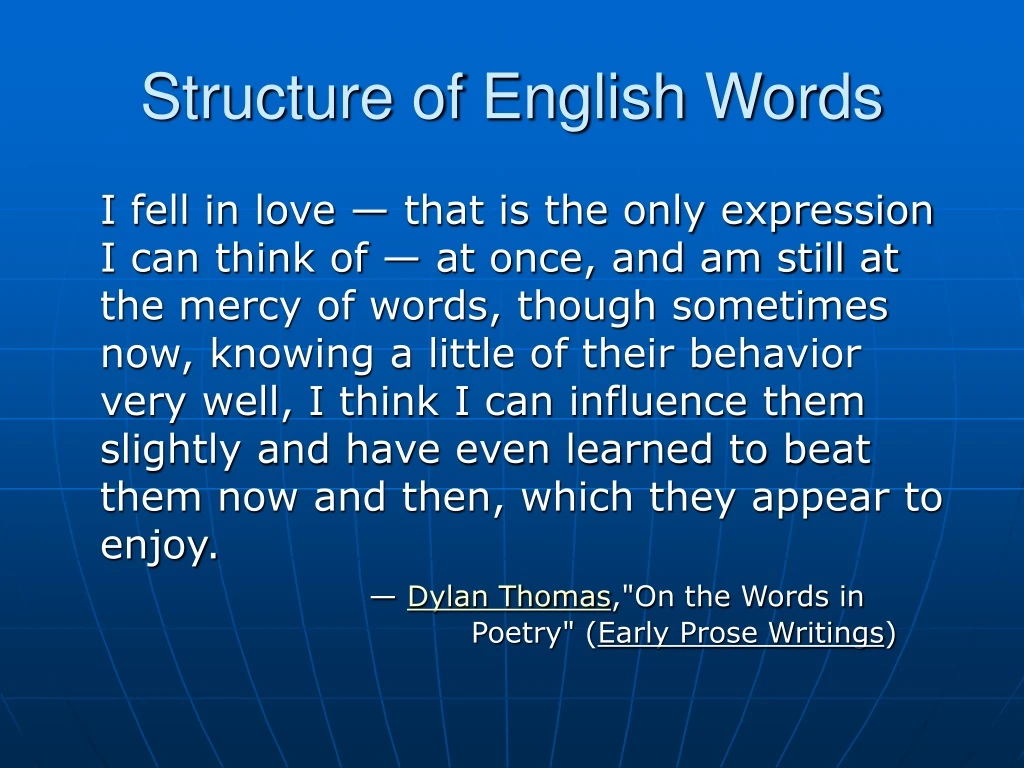
Skip this Video
Loading SlideShow in 5 Seconds..
Structure of English Words PowerPoint Presentation
Structure of English Words.
Uploaded on Dec 19, 2019
Download Presentation
Structure of English Words
— — — — — — — — — — — — — — — — — — — — — — — — — — — E N D — — — — — — — — — — — — — — — — — — — — — — — — — — —
Presentation Transcript
-
Structure of English Words I fell in love — that is the only expression I can think of — at once, and am still at the mercy of words, though sometimes now, knowing a little of their behavior very well, I think I can influence them slightly and have even learned to beat them now and then, which they appear to enjoy.— Dylan Thomas,»On the Words in Poetry» (Early Prose Writings)
-
What’s special about English? Three extraordinary features: • most widely spoken • largest vocabulary • structurally flexible
-
Spread of Englishhttp://www.sterlingtimes.org/memorable_images36.htm
-
Vocabulary size • Russian: 130,000 words
-
Vocabulary size • French: 150,000 words • Russian: 130,000 words
-
Vocabulary size • German: 200,000 words • French: 150,000 words • Russian: 130,000 words
-
Vocabulary size • English: 450,000 words • German: 200,000 words • French: 150,000 words • Russian: 130,000 words
-
The flexibility of English: • One word leads to another … • Endings acquire new life • Parts of speech gain new roles
-
1. clique = French ‘club, gang’ OED: • cliquish, a. hence, cliquishly • cliquism • cliquy, -ey, a. hence, cliquier, cliquiest, cliquiness Also: “to clique”
-
2. -ee • employee • advisee • amputee • draftee (see -Frenchfiancee, etc.)
-
Words in –ee that French couldn’t (or wouldn’t) have • absentee • standee • donee • devotee
-
-ista • fashionista • barista
-
Flexibility • Inventiveness:, or fiddling with rules • Nouns as verbs • Nouns as adjectives • Prepositions (adverbs?) as adjectives • Predicate phrases as adjectives
-
1. Nouns as verbs Memo from a colleague: Please calendar this important event and encourage your colleagues to attend.
-
2. Nouns as adjectives • “I love its streetness.” • “It’s so niche.” • “This is so last year.”
-
3. Nouns as “adjectives” • paper towels • plant disease diagnosis • plant disease diagnosistechnology
-
4. Verb phrases as adjectives Bill Bryson’s Walk in the Woods [is] choke-on-your-coffee funny. -Washington Post book review
-
The Richness of English Puns: • auto dentist • entreprenerd
-
CrackBerry
-
metrosexual
-
The Richness of English Images (Metaphors): • reveal • divulge • depend • subject • Vermont • California • dilapidated • volume
-
Ambrose Bierce,Devil’s Dictionary, 1911) • Dilapidated for Ruined. Said of a building, or other structure. But the word is from the Latin lapis, a stone, and cannot properly be used of any but a stone structure. • Donate for Give. Good American, but not good English.
-
The Richness of English Exercise: Make a list of all the verbs in English containing the root press.
-
verbs in press: • compress • depress • express • impress • oppress • suppress • repress • re-press • decompress • re-express • immunosuppress • bench-press
-
Using familiar wordsto learn new ones • opposite = ‘placed against’ • apposite = ‘placed near’ • “I stumbled on this apposite quote …” (SF Chronicle, 7/27/2004)
-
Novel Prefixesand Suffixes
-
-gate Watergate Irangate Nannygate Enrongate
-
Mc- Mcmansion McJob McBullies (school officials who forced kids to attend a McDonald’s event)
-
-holic workaholic TiVoholic
-
-rama: • panorama • Futurama (1939 World’s Fair) • Cinerama (1950’s) • smellorama
-
Creative Uses of Existing Prefixes • prebuttal • prequel
-
Blends smog, smaze, motel, …
-
cosmeceutical
-
Jamerican: International Jamerican Film & Music Festival, 2003 Nuyorican: Nuyorican Poets’ Cafe
-
infotainment infomercial mockumentary crockumentary
-
your smileage may vary —NY Times 12/30/07
-
starchitect —NY Times 12/30/07
-
New coinings bling bling phish
-
blogosphere
-
fatosphere‘blogs written by fat people’ —NY Times, 1/23/08
-
The following completely new entries from PU to QU alphabetically were added to OED Online , 12/2007
-
purry, adj. purt, v. pus-gut, n. pus-gutted, adj. push and shove, n. push-back, adj. and n. pustulated, adj. pustulent, adj. puttanesca, n. putt-putt, n. putu, n. putu pap, n. put-up-or-shut-up, adj. putz, v. puy lentil, n. py, n. pycnodysostosis, n. pycnogenol, n. Pynchonesque, adj. pyoderma gangrenosum, n. pyribole, n. pyridinium, n. pyritified, adj. pyro, n.2 pyro, n.3 pyroelectrical, adj. pyroelectrically, adv. pyrograph, n. que sera sera, int. and adj. Quetzalcoatlus, n. queued, adj.2 quibbing, n. quibbing, adj. quick cut, n. and adj. quick-march, v. quick-set, adj.2 quick smart, adv. quidding, n.1 quidding, n.2 quidlibet, n. quilombo, n. Quimper, adj. and n. quinaldine, n. quince, n.2 quinceañera, n. Quinkan, n. quinolizine, n. quinolone, n. quinovose, n. Quinquatria, n. quinquertium, n. quintuplicate, v. quinzhee, n. Quirites, n.
-
j. pyrolithic, adj.2 pyrophyte, n. Pyrosoma, n. pyrothere, n. pyrotoxin, n. Pyrrhonical, adPyrrhonically, adv. pyrrhuloxia, n. pysanka, n. Pythagoras, n. Pythagorico-Platonic, adj. Pyu, n. Pyx, n.2 Qallunaaq, adj. and n. Qallunaat, n. QALY, n. qawwal, n. qawwali, n. qigong, n. Qin, n.1 and adj. qin, n.2 qindar, n. qindarka, n. Qing, n. and adj. qipao, n. Q-tip, n. qtr., n. quad, n.9 quad, n.11 Quadi, n. quadplex, n. quadrans, n. Quadrans Muralis, n. quadrantally, adv. quadrathlon, n. quadringenary, n. quadringentenary, adj. quadringentennial, adj. quadrominium, n. quadrupedalism, n. quadruplicated, adj.
-
quadruply, v. quagging, adj. quagmired, adj. quahogger, n. quailed, adj.2 Qualitätswein, n. quangoland, n. quant, adj. and n.3 quantifiability, n. quantitative analyst, n. quanton, n. quantum valeat, adv. quantum valebant, n. and adj. quantum valebat, n. Quapaw, n. and adj. quar, v.3 quarter pipe, n.1 quarter pipe, n.2 -quarterth, comb. form quarter time, n. and adv. quartzine, n. quashable, adj. quasilinear, adj. Quasimodo, n.1 quasiperiodicity, n. quasispecies, n. quattrino, n. qubit, n. queanie, n. quebrachitol, n. Quechan, n. and adj. queek, v. queek, int. (and n.) Queen Alexandra, n. Queenborough mayor, n. queer-bash, v. queercore, n. Queer Nation, n. quel, adj. (and adv.) Quelle, n. quelle surprise, int. quena, n. quenchant, n.
-
The following completely new entries from across the alphabet were added to OED Online , 12/2007
-
adelic, comb. form alfoil, n. bap, n.2 blankie, n. blind copy, n. breathability, n. Cabrales, n. Cahita, n. and adj. Chicana, n. and adj. Chicanismo, n. cholent, n. clap skate, n. contestability, n. cooch, n. coochie, n. coochie-coochie, n. coochy coo, int. cooze, n. coozie, n. cosmo, n. cotch, n. cotch, v. crabstick, n.2 cranachan, n. depleter, n. diphone, n. dogging, n.2 droit de suite, n. Earl Grey, n. fembot, n. fiend, v. fiqh, n. flambé, n.2 flambé, v.
-
funt, n. galactically, adv. gearhead, n. ginch, n. Godzone, n. green goddess, n. hawala, n. hawaladar, n. helmer, n. humbucker, n. ichthus, n. -istan, comb. form jack, v.3 jandal, n. JAP, n.2 jit, n.3 kabloona, n. kabloonat, n. ka-boom, int. and n. khula, n. ki, n.2 lockdown, n. mis-, prefix1 ozone, n. populate, v.2 power, n.1 shagadelic, adj. snagging, n.3 Srimati, n. -stan, comb. form sunbake, n. sunbake, v. sunbaking, adj. -tastic, comb. form Usui, n. valiha, n. wakizashi, n. webmistress, n. wet room, n. whippit, n. zindabad, int. (and n.) Zoque–Mixe, adj. and n.
-
Also, a number of new subordinate entries were added to existing entries. Here is a very small sampling:
-
(Under push-, comb. form) push broom push factor push mower push-penny push poll push-polling push-to-talk (Under pusher, n.) pusher propeller (Under puss, n.1) puss caterpillar puss caterpillar moth (Under put, v.) to put aback to put about to put it about to put across to put it across to put apart to put away to put down to put the phone down
-
to put forth to put it forth to put forward to put in to put in the leather to put in a (good) word for to put in a word for to put in a good word for to put on to put it on to put on the pot to put the pot on to put out to put together to put this (also that) and that together to put this and that together to put that and that together to put under to put up to put it up to a person put ’em up put them up to put up (big, good, etc.) numbers to put up numbers to put up big numbers to put up good numbers to put up with to put up a job to put up an (also †one’s) appearance to put up an appearance to put up one’s appearance to put up or shut up
Разделы презентаций
- Разное
- Английский язык
- Астрономия
- Алгебра
- Биология
- География
- Геометрия
- Детские презентации
- Информатика
- История
- Литература
- Математика
- Медицина
- Менеджмент
- Музыка
- МХК
- Немецкий язык
- ОБЖ
- Обществознание
- Окружающий мир
- Педагогика
- Русский язык
- Технология
- Физика
- Философия
- Химия
- Шаблоны, картинки для презентаций
- Экология
- Экономика
- Юриспруденция
Содержание
-
1.
The meanings of English words -
2.
The words:a plagiarisma conclusiona functiona tangenta coordinate -
3.
A plagiarism Meaning of the word:Part of -
4.
functionMeaning of the word:Part of speech – -
5.
tangent Meaning of the word:Part of speech -
6.
Coordinate Meaning of the word:Part of speech -
7.
Thank you for your attention -
8.
Скачать презентанцию
The words:a plagiarisma conclusiona functiona tangenta coordinate
Слайды и текст этой презентации
Слайд 1The meanings of English words
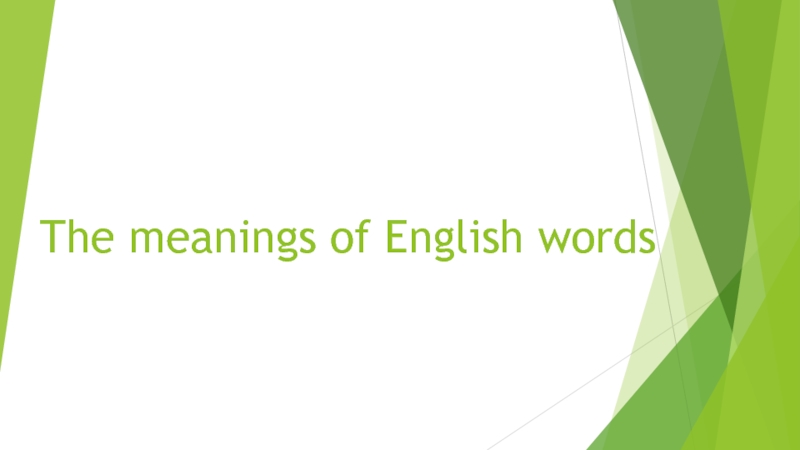
Слайд 2The words:
a plagiarism
a conclusion
a function
a tangent
a coordinate
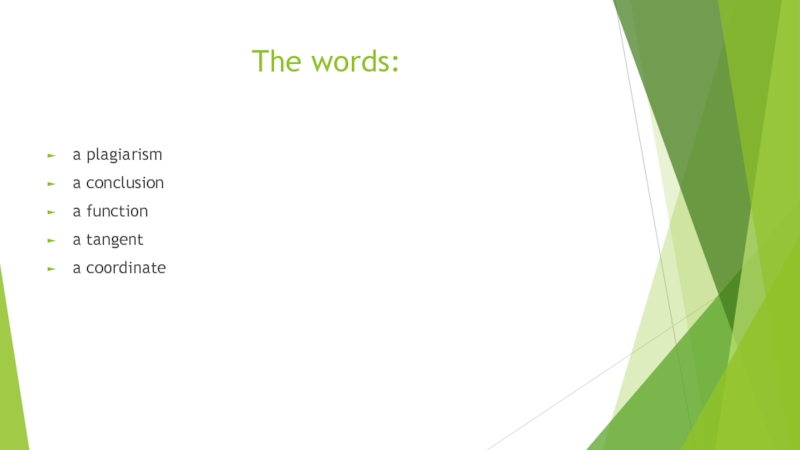
Слайд 3A plagiarism
Meaning of the word:
Part of speech – noun
(Uncountable) The
act of plagiarizing: the copying of another person’s ideas, text,
or other creative work, and presenting it as one’s own, especially without permission.
(uncountable) Text or other work resulting from this act.
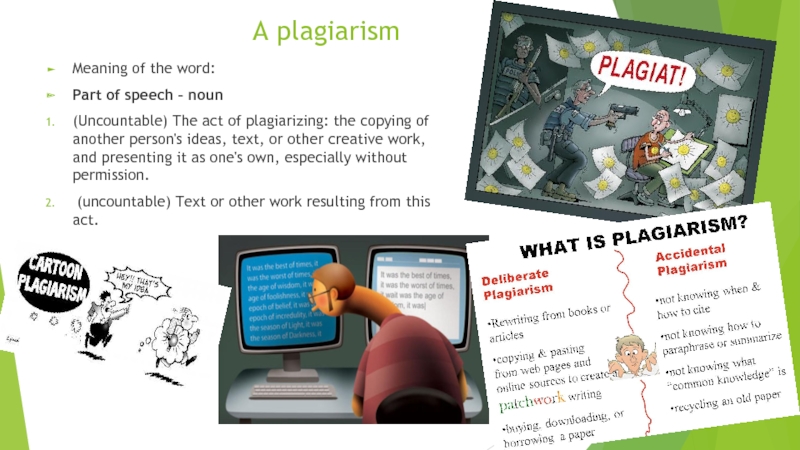
Слайд 4function
Meaning of the word:
Part of speech – noun
A relation where
one thing is dependent on another for its existence, value,
or significance.
(mathematics) A relation in which each element of the domain is associated with exactly one element of the codomain.
(computing) A routine that receives zero or more arguments and may return a result.
(biology) The physiological activity of an organ or body part.
(chemistry) The characteristic behavior of a chemical compound.
(anthropology) The role of a social practice in the continued existence of the group.
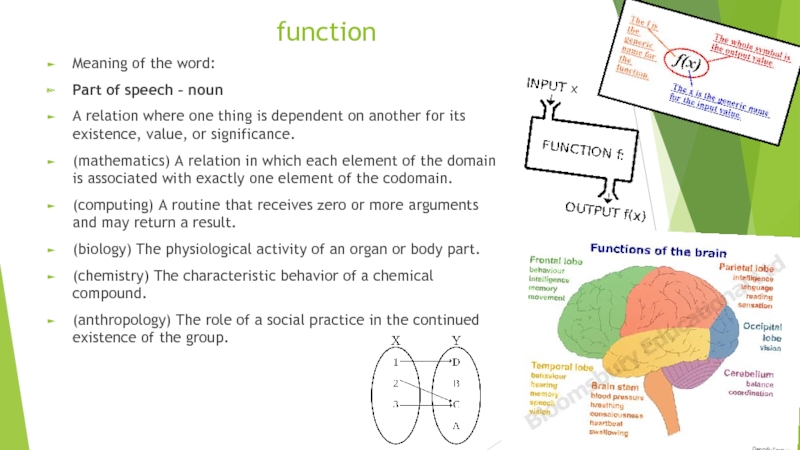
Слайд 5tangent
Meaning of the word:
Part of speech – noun
(geometry) A straight
line touching a curve at a single point without crossing
it there.
(trigonometry) In a right triangle, the ratio of the length of the side opposite the angle to the length of the side adjacent to the angle. Symbols: tan, tg
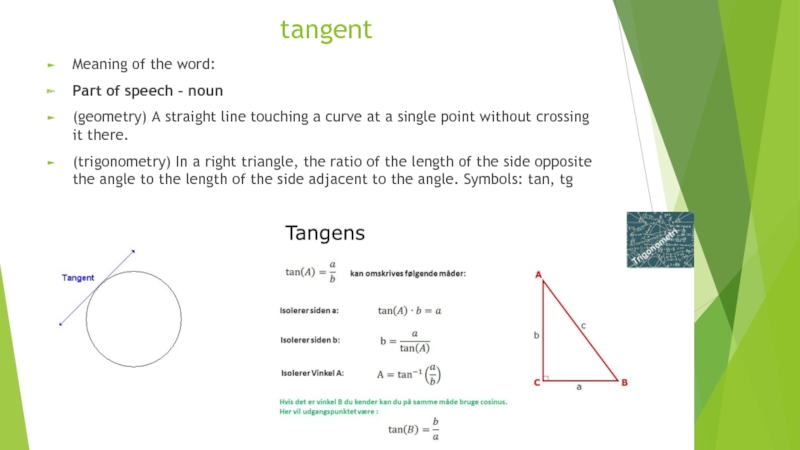
Слайд 6Coordinate
Meaning of the word:
Part of speech – noun
(mathematics, cartography) A
number representing the position of a point along a line,
arc, or similar one-dimensional figure.
Something that is equal to another thing.
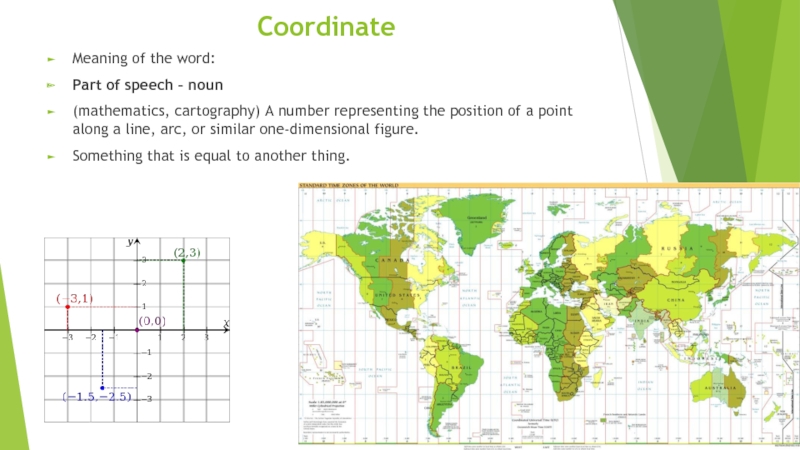
Слайд 7Thank you for your attention










































![The identity-of-unit problem
Variants of the word:
phonetic
automatic: a book – an apple
accentual: ‘territory – terri’tory
emic: direct [di’rekt, dai’rekt]
morphological: grammatical: learn-learned, learnt
lexical: stylistic – stylistical
semantic: sweet tea – a sweet voice](https://myslide.ru/documents_3/a439cbfe8ba5bd18666f73315459b124/img8.jpg)





















































































